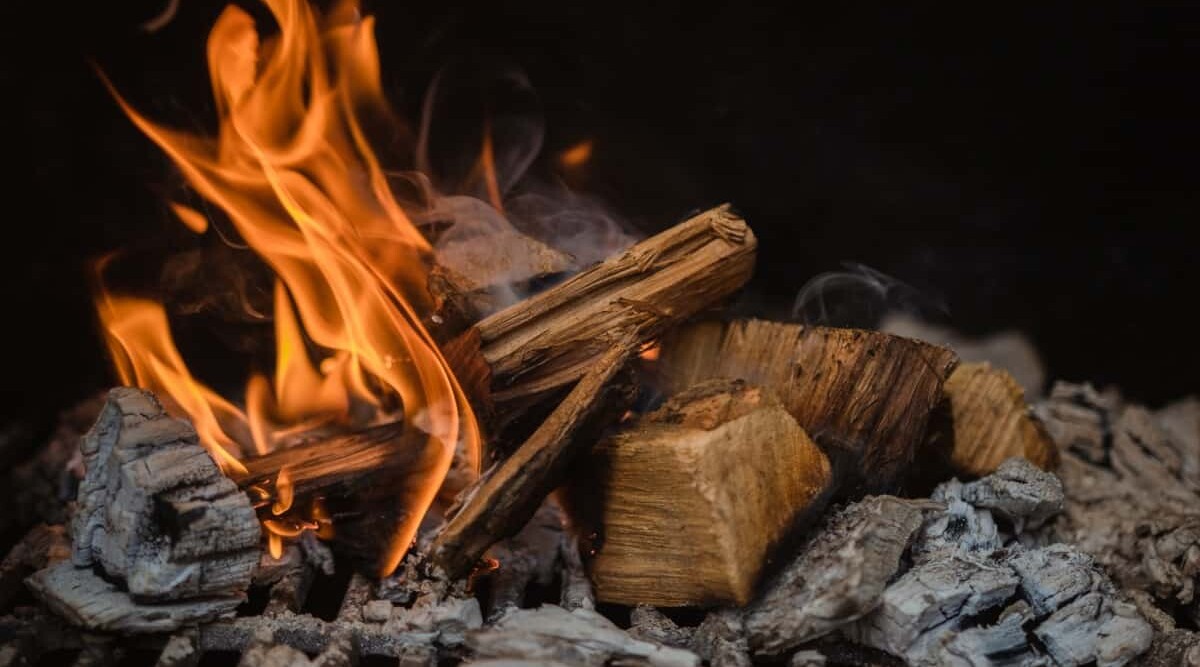
Discover the secrets behind the smoke with this ultimate guide to smoking wood. Because the key to exceptional smoked food is not just in the choice of meat or seasoning but in the type of smoking wood used, how it burns, and the characteristics of the smoke created.
I’ve spent years around the smoker, perfecting the art of wood selection and usage. This guide distills those years of experience into practical advice that will transform your approach to smoking meat.
This guide goes beyond basic tips, offering you a deep dive into the science of smoke and its impact on food flavor. You’ll discover how different woods affect flavor profiles, why certain woods pair better with specific meats, and how to manage wood for optimal smoke production. You will learn about the stages of wood burning, the importance of smoke quality, and the enigmatic smoke ring.
I’ll also address common questions, such as whether to soak your wood or remove the bark.
So grab your notepad and get ready to up your smoking game.
Key Takeaways
- Different woods have different flavor profiles and pair better with specific meats.
- Popular smoking woods are alder, apple, ash, beech, birch, cedar, cherry, chestnut, hickory, maple, mesquite, oak, olive, orange, peach, pear, pecan, plum, and walnut.
- Understanding the four stages of wood burning is crucial for achieving optimal smoke flavor.
- Clean blue smoke is desirable, while thick white or black smoke can impart unpleasant flavors.
- It is important to avoid certain woods for smoking due to taste or toxicity.
- Different forms of smoking wood, such as logs, chunks, chips, pellets, and sawdust, have specific uses and are suited to different types of smokers.
- The amount and timing of adding smoking wood depends on the type of smoker used and personal preferences.
- The smoke ring, a pink band that forms on the surface of smoked meat, is a result of nitric oxide reacting with myoglobin in the meat. It does not affect flavor.
- Properly sourcing and preparing smoking wood is essential for optimal results, including air-drying or kiln-drying the wood before use.
- Soaking smoking wood is not necessary and only delays smoke production.
- The bark on smoking wood can be removed or left on based on personal preference, but birch bark should always be removed.
Jump to:
- 1 Key Takeaways
- 2 Why do We Smoke Meat Anyway?
- 3 How Does Wood Smoke Flavor Food?
- 4 The Four Stages of Wood Burning, and How They Create Flavor
- 5 We Want Clean Blue Smoke, Not Dirty Thick White or Black!
- 6 What are the Most Popular Smoking Woods and Food Pairings?
- 7 Are There Woods you Need to Avoid for Smoking?
- 8 Best Woods for Different Meats
- 9 Logs, Chunks, Chips, Pellets, and Sawdust, When and How to Use Each
- 10 How Much Wood to Use and When to Add it — It Depends on Your Type of Smoker!
- 11 How Long Should You Create Smoke for?
- 12 A Few Words on The Smoke Ring
- 13 Sourcing Your Smoking Wood
- 14 How to Prepare Wood for Smoking
- 15 Should You Soak Your Smoking Wood?
- 16 Should You Remove the Bark?
- 17 Wood Chunk and Tree Identification Guide — Photos and Descriptions
- 18 Further Resources for Identifying Trees
- 19 Conclusion
Why do We Smoke Meat Anyway?
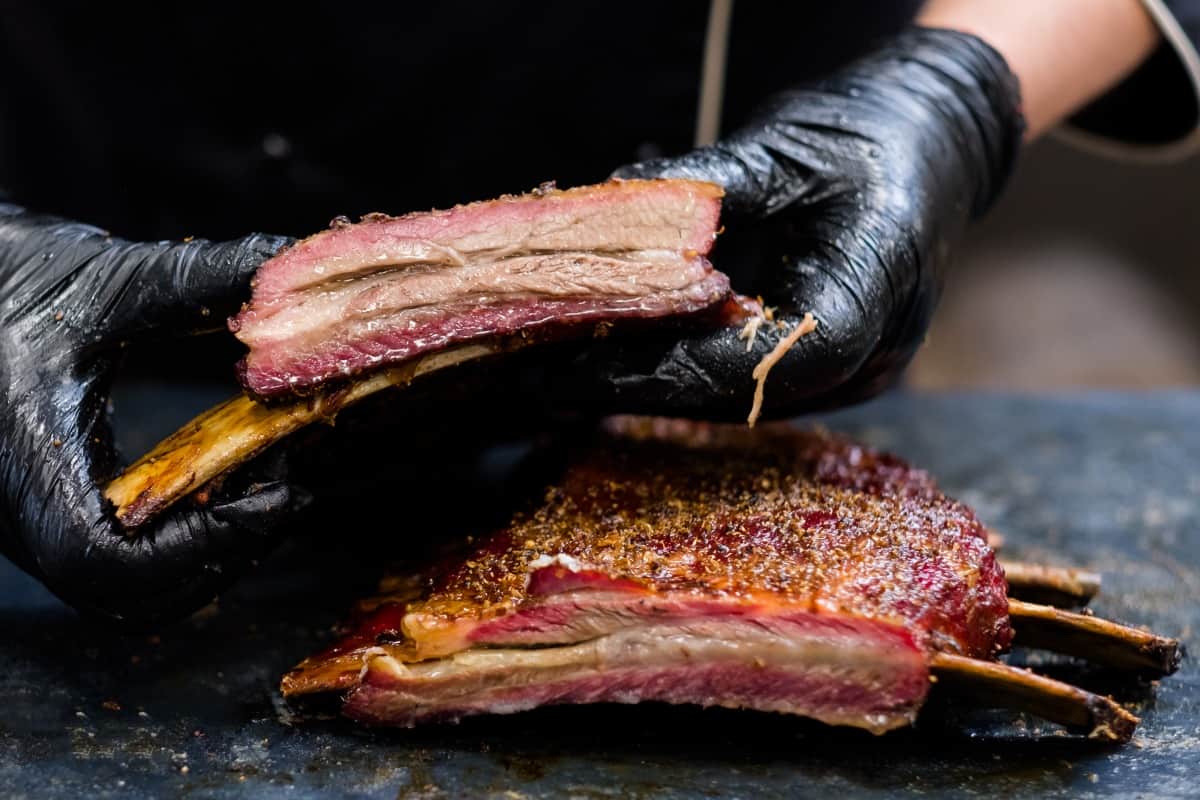
Quite simply, we smoke meat because it’s absolutely delicious! Have you ever eaten plain boiled ribs? Or straight oven-roasted ribs? They’re OK, but nothing to write home about. However, smoked ribs? Oh my!
Smoke takes flavor up a notch. It’s an upgrade for already tasty foods and can bring out further and accentuate the luscious meaty flavors we crave.
Smoke is what differentiates barbecue and grilling from all other types of cooking. It’s the layer of flavor that can only be added by barbecuing.
How Does Wood Smoke Flavor Food?
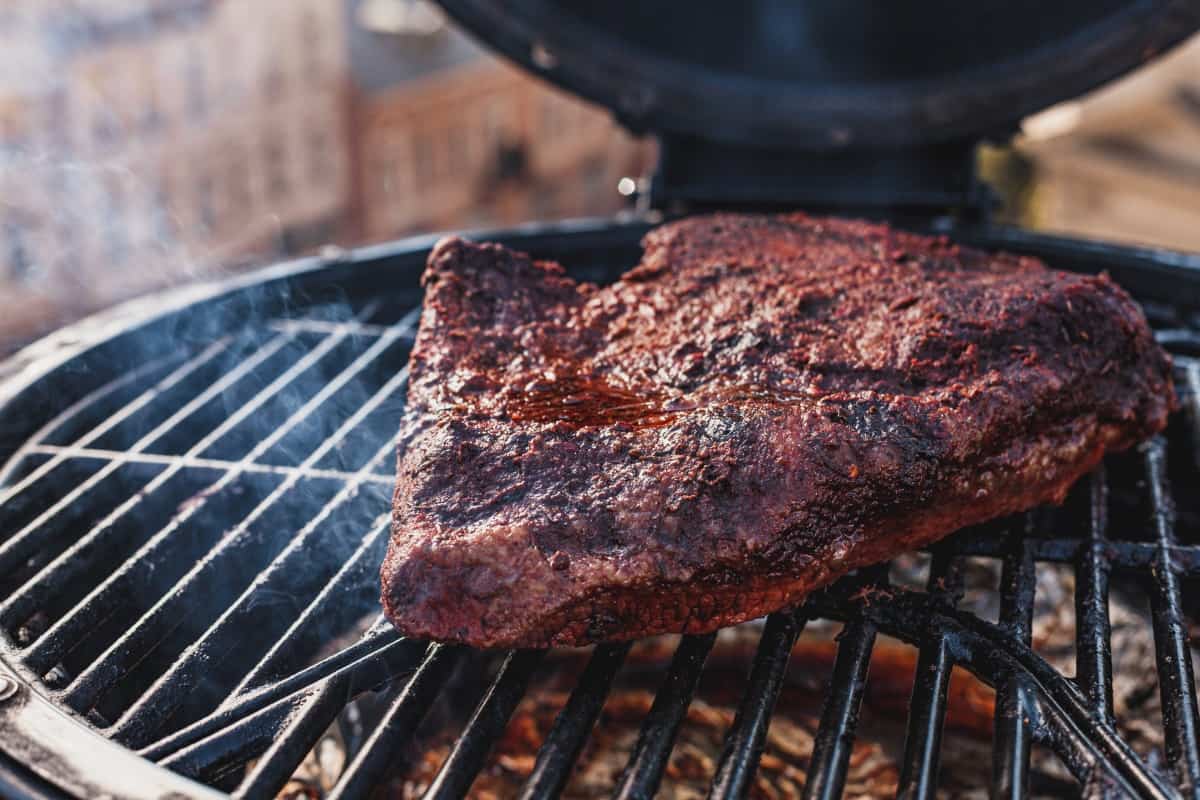
Wood smoke flavors food through a complex process involving heat, chemical reactions, and the unique properties of the wood itself. First of all, we need to understand the composition of wood, which is the following core elements (with percentages indicated if ALL the water was removed):
- Cellulose (40%-60%) — a polymer that crystallizes to create strong fibers. Cellulose is the principal wood-strengthening ingredient.
- Lignin (20%-30%) — a polymer that doesn’t have a clearly defined shape or form, unlike crystalline cellulose. Lignin serves as a matrix or binder for cellulose and is responsible for wood’s strong, fibrous texture.
- Hemicellulose (20%-30%) — a semi-crystalline polymer that also serves as a matrix or binder.
- Extractives —The organic impurities that give wood its color, fragrance, and, in certain circumstances, resistance to rot, fungi, and insects.
- Trace amounts of minerals, including potassium, sodium, and calcium salts and oxides, in amounts that differ depending on the makeup of the soil in which the tree is grown in
Cellulose and hemicellulose in wood are types of sugars, which explains why wood smoke adds sweet flavors to food. So wood could almost be considered a sugar stick, mixed with lignin to give it a solid, woody structure, then soaked in water.
Burning wood goes through four distinct stages, before ending in ash. Understanding these stages is crucial for smoking food, as various compounds and flavors emerge at different temperatures and times. Some of these compounds are desirable for flavor, while others are not.
So let’s look at the four stages of wood burning and how they affect flavor:
The Four Stages of Wood Burning, and How They Create Flavor
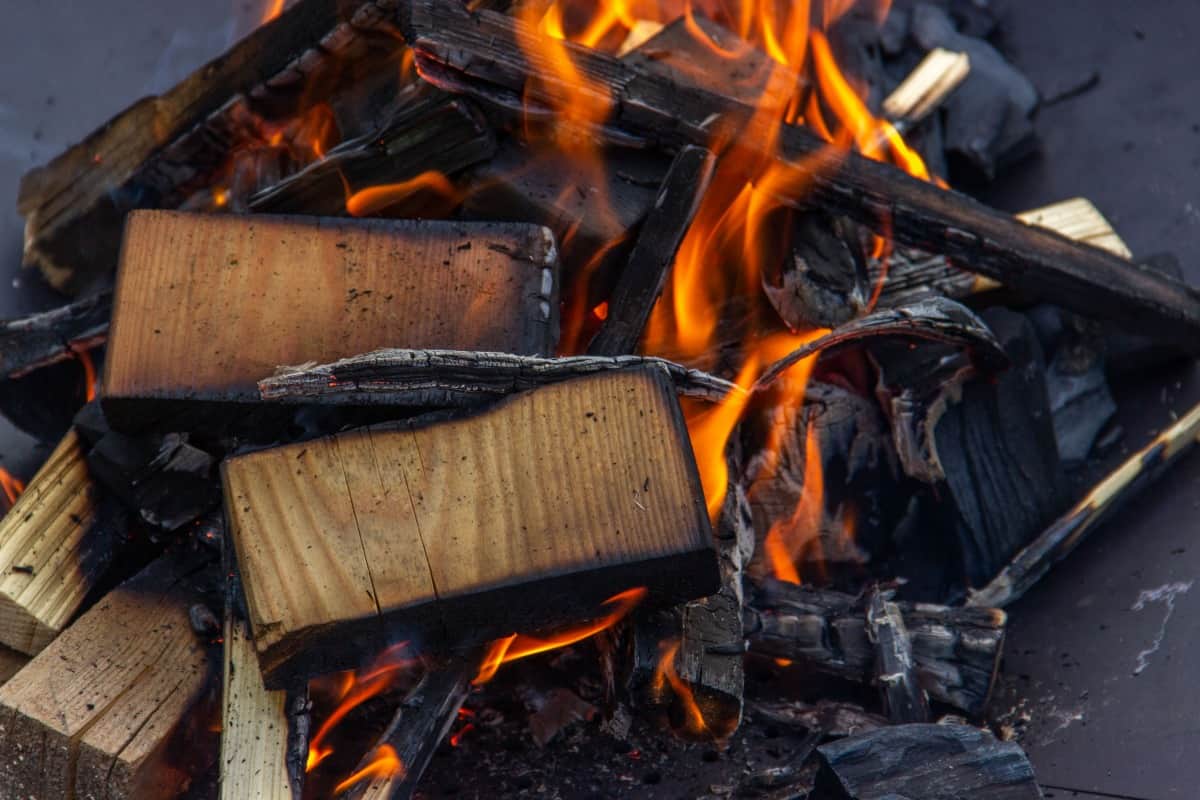
As detailed in this great article by genuineideas.com, wood burns in four stages, incompletely and in a specific order.
It’s crucial to understand that while we identify four distinct stages of wood combustion, they actually occur simultaneously in varying amounts throughout the wood in the fire.
Ideally, we aim to manage our fire to maintain the wood in the third stage of combustion, as this stage imparts the best flavor to our food.
Stage 1 is Evaporation and Dehydration
Evaporation and dehydration takes place when the wood temperature is below 500 °F. During this phase, moisture in the wood transforms into steam and is released, along with some CO2 and methanol. There’s no fire or significant heat at this point.
No flavor is imparted to the food during this stage.
Stage 2 is Pyrolysis and Gasification
Pyrolysis and gasification occurs when the wood temperature is between 500 and 700 °F.
“Pyro,” from pyrolysis, means “fire,” commonly seen in terms like pyrotechnics (for you Def Leppard fans) and pyromania. Yet, ironically, there are no visible flames at this stage
Pyrolysis is the chemical decomposition of materials at high temperatures. It breaks down molecules into smaller ones or forms solid compounds and residues. Inside the wood, pyrolysis produces oily substances and volatile compounds
Gasification, a similar process, occurs on the wood’s surface, releasing gases like carbon monoxide (CO), carbon dioxide (CO2), methane, and water vapor.
During this stage, hemicellulose breaks down into acids, ammonia, and volatile gases; cellulose into tars and additional gases; lignin into various aromatic compounds.
The wood also emits dense white smoke comprising water vapor, gases, soot, and creosote, indicating incomplete combustion and the wood being in stage 2 pyrolysis. Thick clouds of white smoke from BBQ smoking wood often mean the fire isn’t hot enough, and combustion isn’t complete.
Stage 3 is Burning Bush, Ignition and Combustion
Ignition and combustion occurs when the wood reaches temperatures between 700 and 1,000 °F.
At these temperatures, gases and vapors like hydrogen, methane, and carbon monoxide ignite, creating a flaming fire. Also, ammonia and hydrogen cyanide react with oxygen to form nitric oxide, contributing to the smoke ring. This process is discussed further in a later section.
Flavorful, aromatic smoke arises from the combustion of lignins between 650 and 750 °F. Above 750 °F, lignins still produce aromas but also break down into potentially harmful compounds, contributing to concerns about BBQ and cancer.
Stage 3 is where we produce the desirable clean, thin blue smoke that infuses meat with aromatic flavor. We want to maintain our wood-burning at these stage 3 temperatures for the finest smoke and taste..
Stage 4 is Char Burning and Charcoal Formation
Char burning and charcoal formation happens when the wood reaches temperatures over 1,000 °F.
At this point, most organic compounds, sugars, and lignin’s burn off, leaving primarily carbon, also known as char or charcoal.
Charcoal burns at very high temperatures, up to 1500 degrees Fahrenheit, producing minimal smoke without odor or flavor, as it lacks organic chemicals. Therefore, when smoking meat, adding wood to burning charcoal is essential to create flavorful smoke.
We Want Clean Blue Smoke, Not Dirty Thick White or Black!
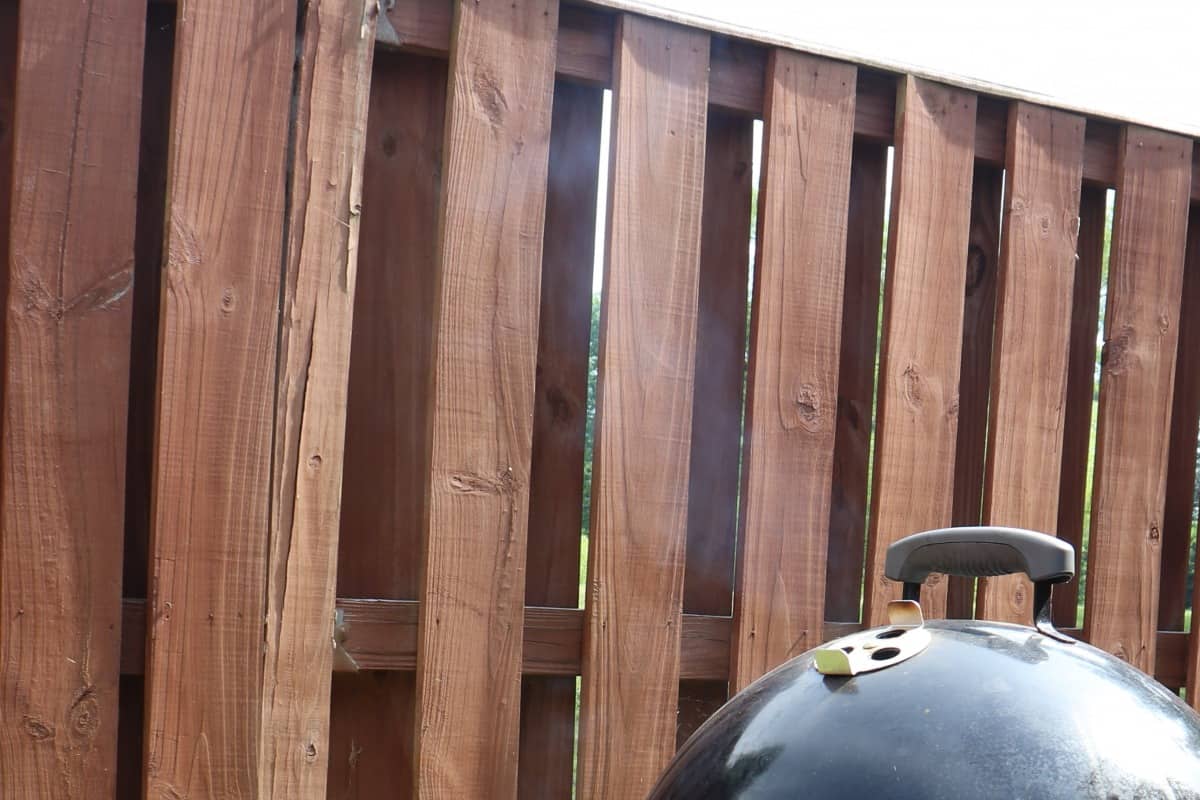
If you’ve been around the BBQ community for any length of time, you will have heard the terms ‘clean blue smoke’ or ‘thin blue smoke.’ But what exactly is it?
Thin blue smoke is smoke with minimal ‘unburned’ solids. In combustion stage 3 ‘burning bush,’ near-complete combustion produces barely visible vapors, gases, chemicals, and aromatics, resembling a thin blue haze. This clean, thin smoke contains desirable flavor compounds without unwanted soot and creosote.
Thick white or gray smoke is laden with acrid-tasting, heavy unburned solids, that can settle on food. In small amounts, this is acceptable, but too much can impart an unpleasant taste.
In stage 2 pyrolysis, incomplete combustion results in dense white or gray smoke, comprising water vapor, gases, and solids like soot and creosote. This thick white or gray smoke is laden with acrid-tasting, heavy unburned solids, that can settle on food. In small amounts, this is acceptable, but too much can impart an unpleasant taste. This stage also fails to fully decompose cellulose, hemicellulose, and lignins into desirable aromatic compounds that we do want to flavor our food.
Achieving complete combustion is challenging without advanced scientific equipment, so some white smoke from BBQs is inevitable. However, our aim is to produce as clean a smoke as possible. This involves ensuring adequate oxygen and heat for the wood to burn and combust properly within the optimal temperature range, maintaining it in stage 3 of the combustion process.
What are the Most Popular Smoking Woods and Food Pairings?
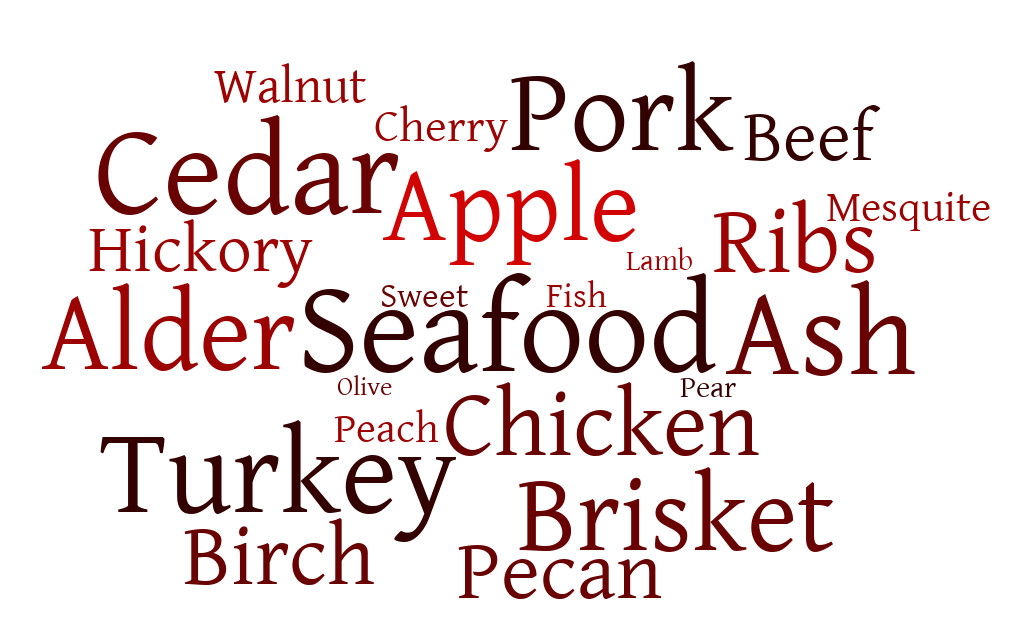
The most popular smoking woods and food pairings are a huge topic of debate in the BBQ community, with a good amount of inconsistency and disagreement when pairing different wood smokes with different meats and foods.
I’ve been BBQing and smoking regularly since 2005, during which time I’ve read dozens of books, hundreds of magazines, and thousands of articles. I’ve seen the subject of pairing smoking woods with various foods is a recurring topic, with varying advice largely influenced by personal preferences and tastes.
So what I’ll do, is provide the most widely accepted pairings from the BBQ community, followed by my personal beliefs and practices.
Smoking Wood and Food Pairing Table
I have listed in the below smoking wood and food pairing table only the most commonly used woods and ones that I have bought and used myself.
In the ‘Flavor Profile’ column, I list the most commonly used words to describe each wood’s flavor. The ‘Food Pairings’ column suggests the meats and foods best paired with each smoking wood.
Remember that this table’s contents are opinions, not absolute facts. They represent generally agreed views, and some pitmasters may disagree.
| Wood | Flavor Profile | Food Pairings |
|---|---|---|
| Alder | Mild and light — Delicate, subtle, slightly sweet, musky. | Fish (particularly salmon), poultry, and light-meat game birds. |
| Apple | Mild to Medium — Light and sweet, slightly fruity. Can be mixed with other woods for great results. | Poultry, beef, pork, (particularly ham), lamb, game birds, and cheese. |
| Ash | Mild — Light, unique flavor. | Poultry, fish and seafood, beef, pork, lamb, game, and game birds. |
| Beech | Mild — Well-balanced, good all-rounder. Can pair with stronger woods to make less overpowering. | Poultry, fish and seafood, beef, pork, lamb, game, game birds, and cheese. |
| Birch | Mild — Clean and not overpowering. Similar to maple. Remove the bark, which is oily and strong. | Poultry, fish and seafood, and pork. |
| Cedar | Medium — Sweet and tangy. Big, bold flavor, but not strong and overpowering. | Only ever really used for 'planked' fish (particularly salmon.) |
| Cherry | Medium — Subtle, sweet and fruity, to mildly tart. Gives a rosy red tint to meats. Great mixed with oak and apple. | Poultry, fish and seafood, beef, pork, lamb, game, and game birds. |
| Chestnut | Mild — Nutty and slightly sweet, a little tangy. | Poultry, fish and seafood, pork, and cheese. |
| Hickory | Strong — Bold, universal flavor. Sweet and strong. Bacony flavor. Can be pungent. Can be overpowering, good to mix with oak. | Poultry, beef, pork, game, game birds, cheese. Most popular with pork, ribs, and bacon. |
| Maple | Mild — Somewhat sweet, subtle, balanced flavor. | Poultry, fish and seafood, pork, and cheese. |
| Mesquite | Very strong — Strongest of all. Earthy and spicy. Use sparingly. | Beef, pork, and poultry. |
| Oak | Medium — Traditional rustic flavor. Stronger than apple and cherry, lighter than hickory and mesquite. Bold but not overpowering. | Poultry, fish and seafood, beef, pork, lamb, game, game birds, and cheese. |
| Olive | Mild — Similar flavor to mesquite, but very light in comparison. | Best with poultry. |
| Orange | Mild — Light and fruity, tangy and citrusy. Lighter than most other fruit woods. | Poultry, fish and seafood, and pork. |
| Peach | Medium — Sweet and earthy Similar to hickory, but sweeter, fruity and milder. | Poultry and pork. |
| Pear | Medium — Light and sweet, slightly fruity, very similar to apple but lighter. | Poultry and pork. |
| Pecan | Strong — Similar to hickory, not as strong. Sweet and nutty. A good all-purpose, all-rounder. | Poultry, beef, pork, and cheese. |
| Plum | Medium — Sweet, bold, fruity flavor. | Poultry, fish and seafood, and pork. |
| Walnut | Strong — Heavy flavor, can be bitter. Good mixed with sweeter fruit woods. | Beef, pork, and game. |
Other less commonly seen woods I’ve seen people smoke with, and seen for sale as smoking wood, include:
Acacia, almond, apricot, avocado, bay, butternut, carrotwood, cottonwood, crab apple, fig, grapefruit, grapevine, guava, gum, hackberry, kiawe, lemon, lilac, madrone, manzanita, mulberry, nectarine, persimmon, pimento, sassafras, willow, and the oak reclaimed from wine and whiskey barrels.
My Thoughts and Advice
Based on what I’ve read, experienced, and tested over many years, here are my views on wood smoke flavors and food pairings.
Different woods do impart distinct flavors and suit different foods. However, I believe there’s often an exaggerated emphasis on the impact of different wood smokes. The level of detail people go to in wood smoke and food pairings seem to me overly meticulous, almost to the point of absurdity.
Yes, strong wood smokes can overwhelm delicate foods like chicken, fish, and vegetables and should be avoided with these. Conversely, milder smokes may not stand up to robust flavors like a seasoned beef roast, which pairs better with stronger woods.
But consider this: After marinating, injecting, or brining meats like beef, pork, or chicken, then applying a blend of salt, pepper, herbs, and spices, smoking for hours, and finally adding sauce and accompaniments, can you truly determine the subtle differences in wood smoke flavor? In my experience, no.
With the multiple layers of flavor we add to BBQ, distinguishing between meats smoked with woods like ash, beech, or maple, apple, pear, orange, or lemon wood is hard to determine. I, and the many people I’ve cooked for, cannot tell the difference – I’ve conducted such tests.
In my opinion, the most important differences you really need to know and care about are:
- Fruit woods — Give a mild, light, sweeter smoke.
- Nut woods and trees with solid seeds — Give a stronger smoky flavor.
- Mesquite — Out all alone as a VERY strong smoke flavor. Earthy, spicy, very strong. Use sparingly and typically mixed with much lighter woods.
- Oak, hickory, and pecan — Are good all-rounders to give a medium to strong smoky flavor.
- Apple and cherry — Are good all-rounders to give a mild smoky flavor.
- Cherry — Is good for giving a pleasing red hue to meats smoked with it.
My best advice is to obtain two types of wood: one mild and one medium to strong, based on local availability.
For a mild wood, consider fruit woods, with apple being a personal favorite. For a medium to strong wood, choose oak, hickory, or pecan, whichever is readily available and affordable.
Buy one from each group, use these for some time until you get used to using them, and getting the right strength of smoky flavor you like on the different foods you cook.
Once comfortable with these two wood types, then consider experimenting with others.
Can You Mix Smoking Woods?
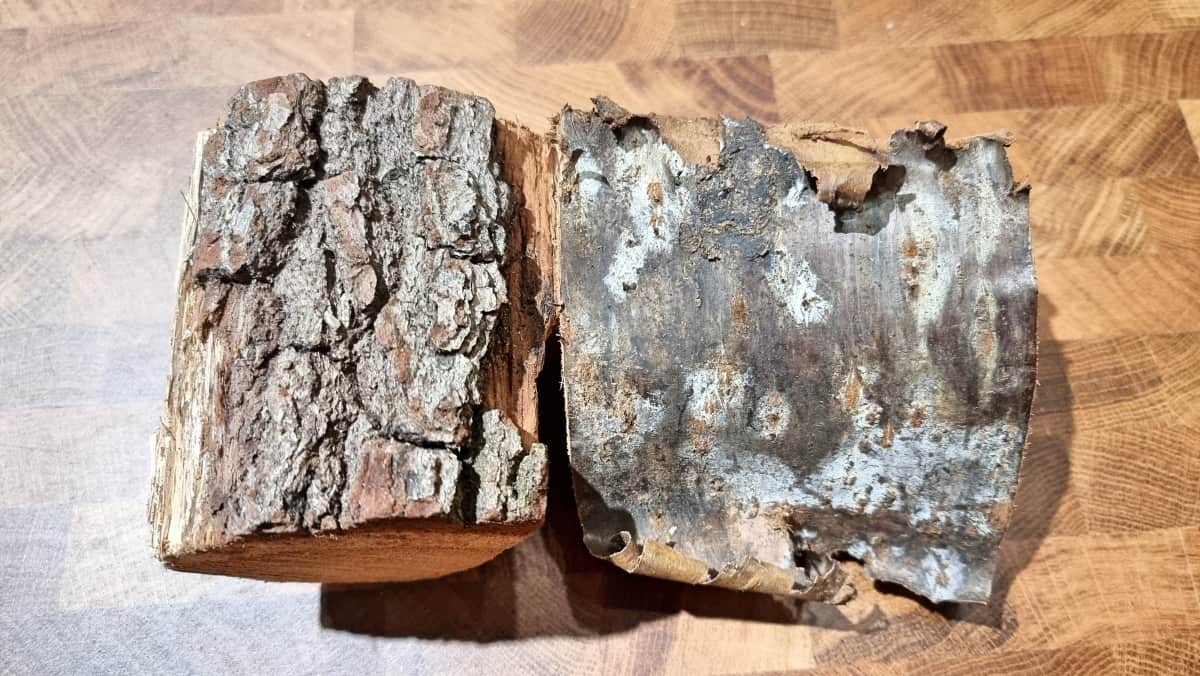
You can mix smoking woods. It’s a common practice to create unique flavor combinations unachievable with a single wood species
For instance, blending strong, earthy, and spicy woods with lighter, fruity, sweet-flavored woods can result in a balanced and complex flavor profile, offering the best of both worlds.
Popular combinations include mixing apple with oak, hickory, or pecan to achieve a blend of complex, earthy, spicy, sweet, and fruity flavors in one smoke.
Another favored pairing is cherry with oak, hickory, or pecan, which covers all flavor bases and imparts a beautiful red hue to meats from the cherry smoke.
Try mixing one of:
- Mesquite
- Hickory
- Oak
- Pecan
- Walnut
With one of:
- Apple
- Cherry
- Orange
- Peach
- Pear
- Plum
Before experimenting with mixing, I recommend smoking with only single species at first to get used to what they taste like. But then, go wild. Smoke is an ingredient, so have a play with it.
Are There Woods you Need to Avoid for Smoking?
Yes, there are many kinds of wood you need to avoid for smoking including aspen, cypress, eastern cedar, elderberry, elm, eucalyptus, fir, hemlock, laburnum, liquidambar, locust, mangrove, oleander, pine, poisonous walnut, redwood, spruce, sycamore, tamarack, tambootie, and yew.
Some of these woods can make food taste horrible, while others are poisonous or contain irritants, and can make you sick.
Further Caveats and Common Sense
You should also
Avoid smoking with these types of wood:
- Wood treated with preservatives.
- Wood possibly treated with herbicides, pesticides, or fungicides.
- Painted, stained, or varnished wood.
- Scaffold boards or pallet wood, which may have been chemically treated or exposed to unknown substances and chemicals.
- Rotted wood or wood with mold or fungus, as burning can release toxins.
- Wood that has contacted poison ivy or similar plants, potentially emitting irritating vapors when burned.
- Wood with an unusual or off smell, as it can transfer to your food.
- Unknown wood species, as it’s not worth the risk.
Best Woods for Different Meats
I covered the best woods for different meats in the table above, but I thought it would be helpful to give more details in a summary for quick reference.
Best Wood for Smoking Beef (Particularly Brisket)
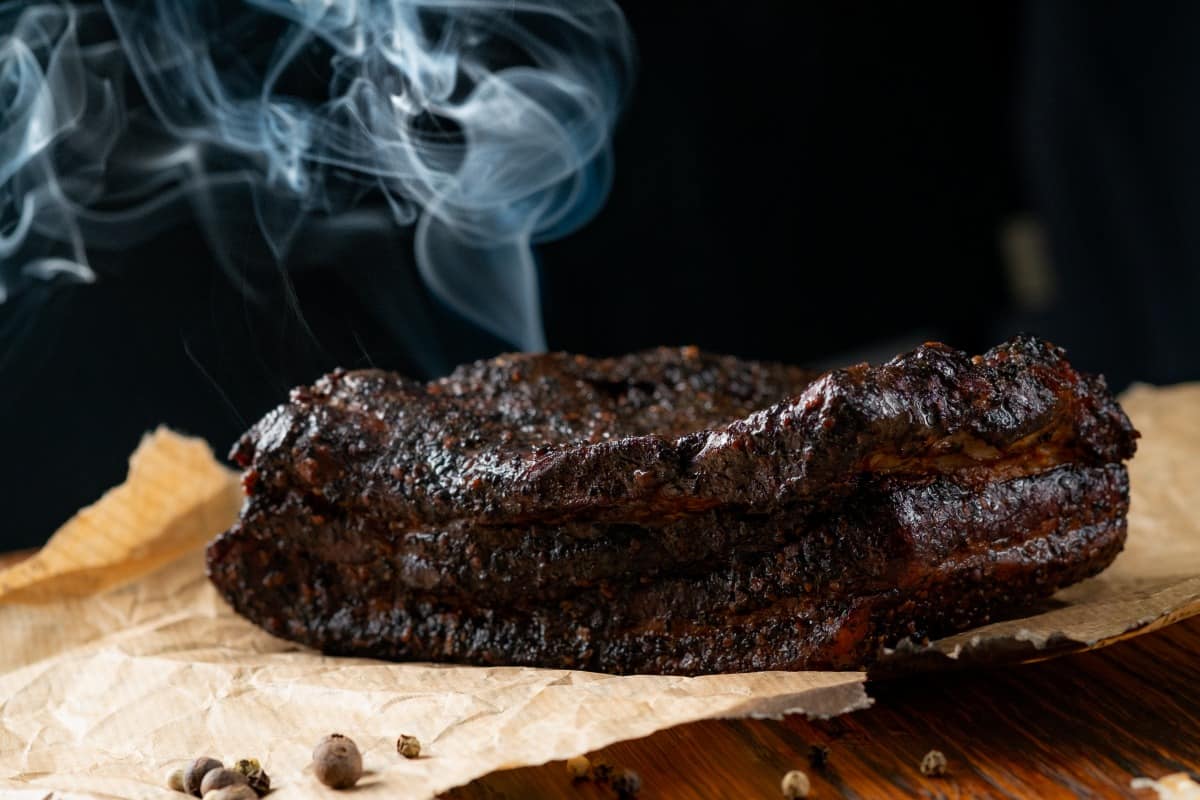
The best woods for smoking beef are:
- Hickory
- Oak
- Mesquite
- Cherry
- Apple
- Maple
- Pecan
Beef is an intensely flavored, dark red meat that benefits from and can stand up to a good hit of medium to strong smoke. Especially brisket!
I’ve discussed this topic in-depth in my article on the best woods for smoking brisket, so you can check that article for a more complete discussion.
Best Wood for Smoking Ribs
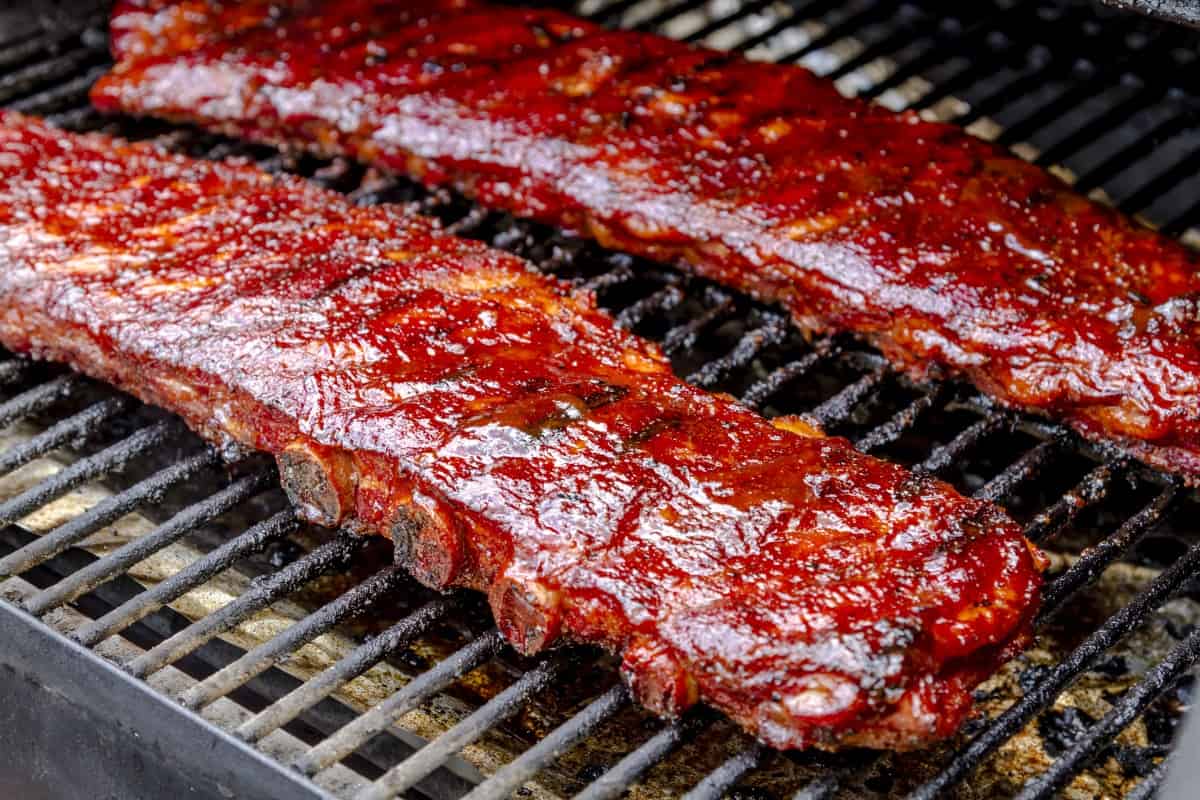
As discussed in our article to the best woods for smoking ribs, If like me, you like a strong, pronounced smoky flavor on your BBQ ribs, these woods should be your top choices:
- Hickory
- Oak
- Pecan
- Mesquite
However, if you like the smoky flavor dialed down a little, these should be your top choices:
- Maple
- Apple
- Cherry
- Peach
Best Wood for Smoking Pork
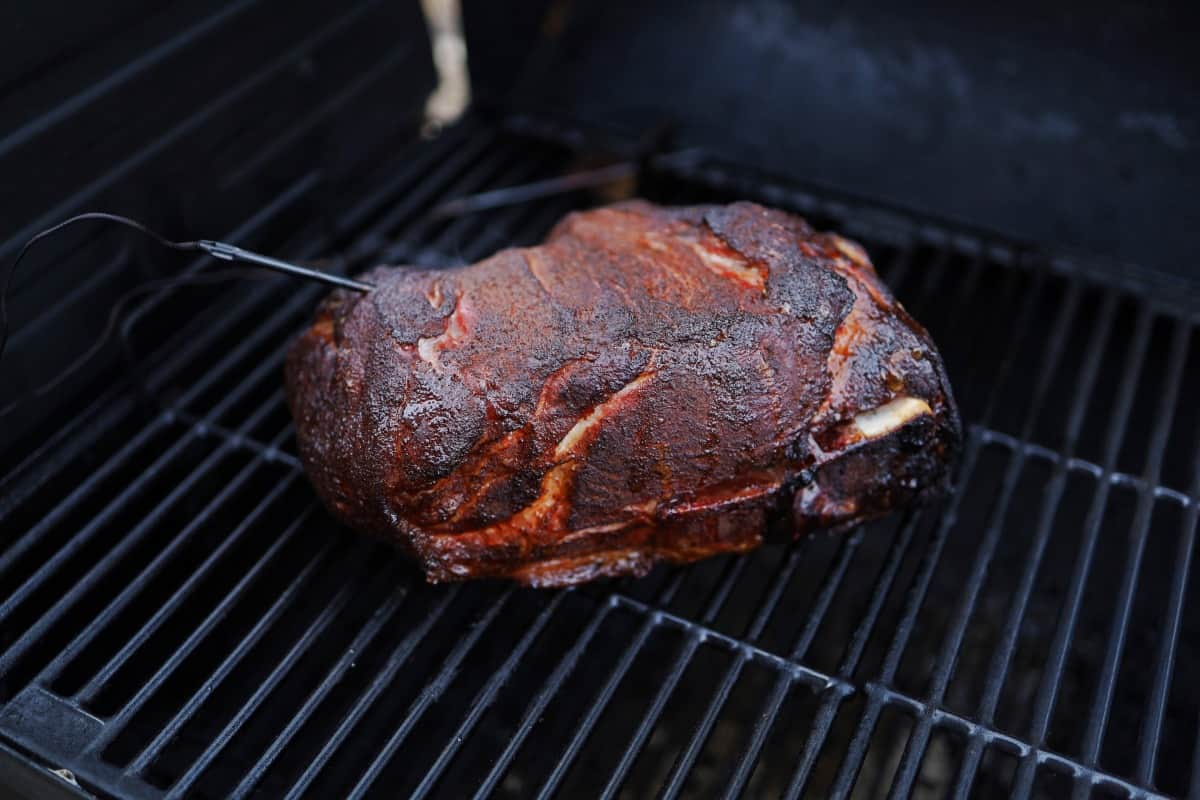
The best woods for smoking pork are the sweeter ones from fruit trees, such as:
- Apple
- Pear
- Peach
- Orange
But if you like a more pronounced smoky flavor, pork also stands up well to bolder smoke from woods such as:
- Hickory
- Maple
- Pecan
- Mesquite (in small doses!)
Pork really is the meat that pairs well with any kind of smoke from any of the acceptable smoking woods. So it comes down to your personal taste.
Best Wood for Smoking Chicken
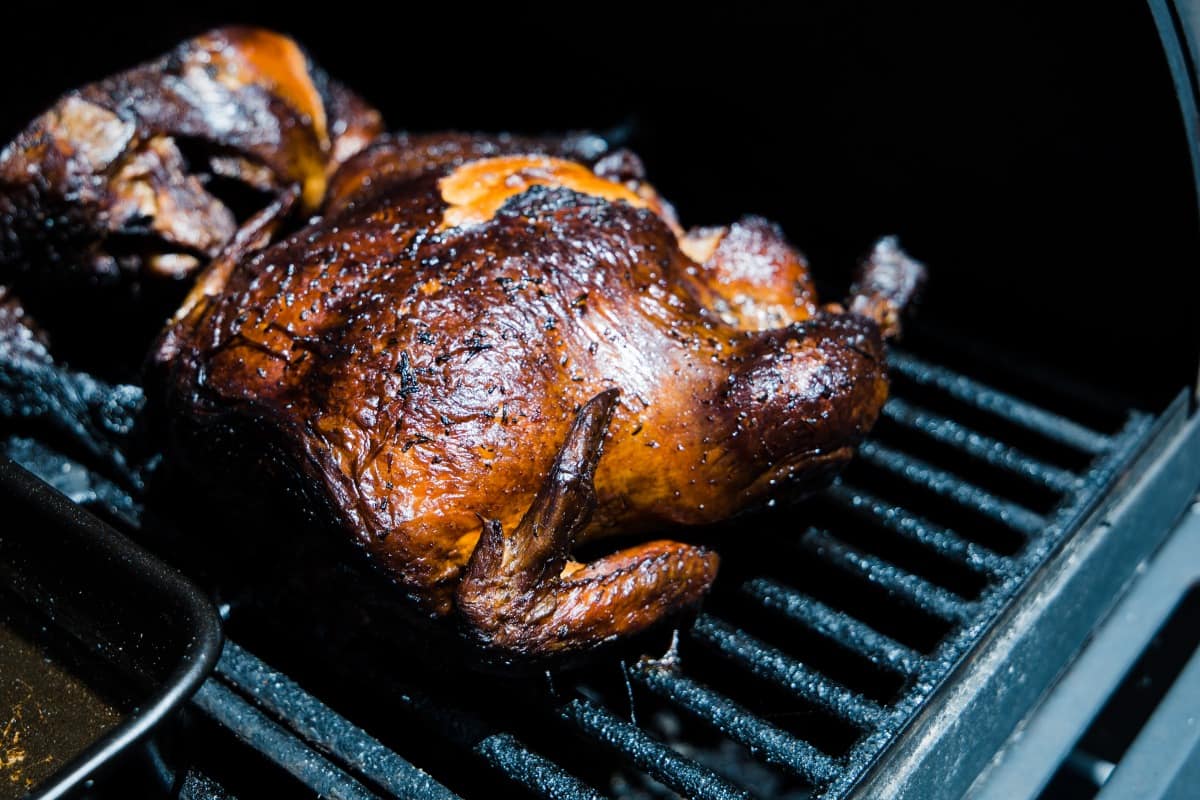
The best woods for smoking chicken that add a mild, complementary flavor are:
- Hickory
- Maple
- Apple
- Cherry
- Peach
- Pecan
Chicken is somewhat delicate and easy to overpower with some of the stronger wood smokes. So avoid intensely smoky hardwoods that you would use on beef, like mesquite, oak, or walnut.
Check out our article on the best woods for smoking chicken for a deeper discussion.
Best Wood for Smoking Turkey
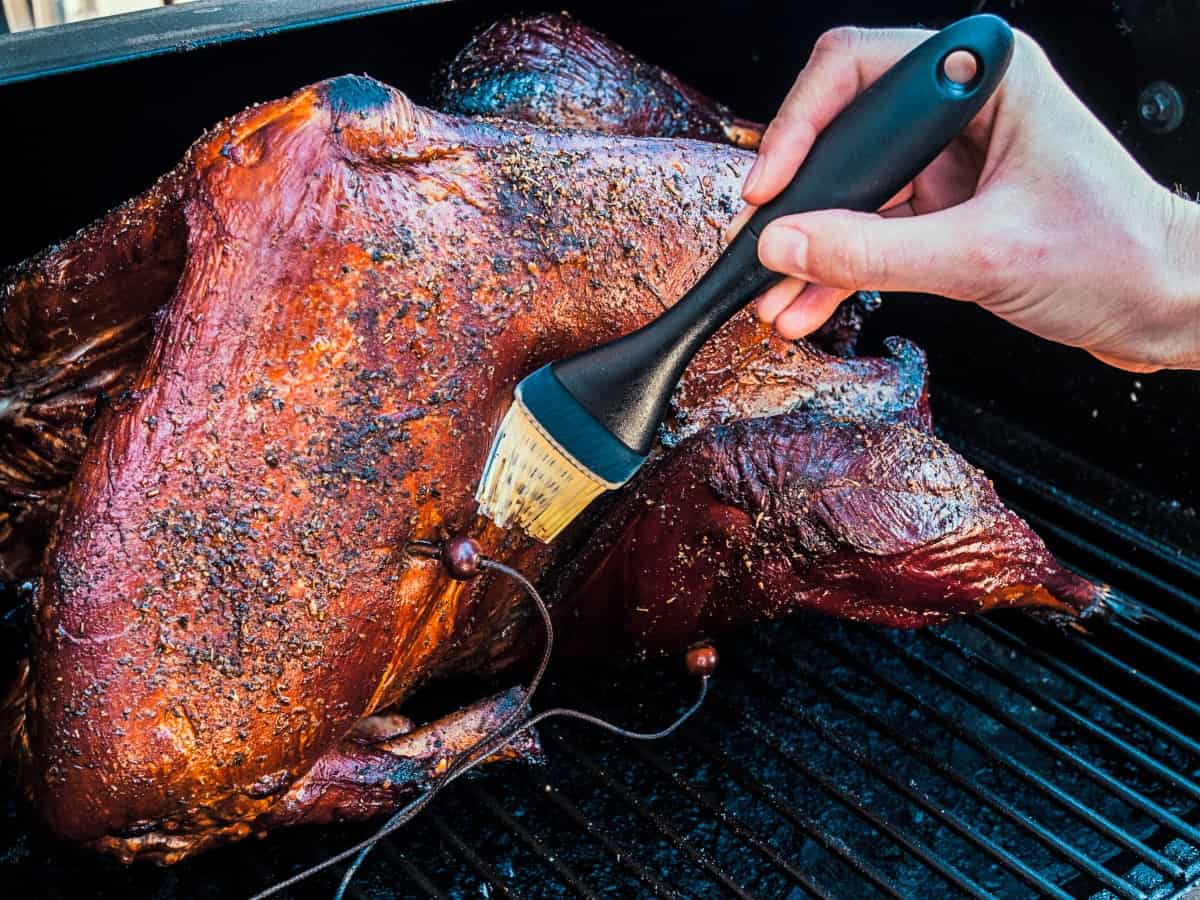
The best woods for smoking turkey that have just enough smokiness to please while still allowing room for sauces, spices, and natural turkey taste are:
- Maple
- Cherry
- Pecan
- Apple
- Alder
Although keeping your smoke light is the best option for turkey, some people like it heavier. Here are a couple of woods to consider if you want your fowl to have a more smoky flavor.
- Mesquite
- Oak
Check out our guide to the best woods for smoking turnkey for a more detailed discussion on the topic.
Best Wood for Smoking Fish and Seafood
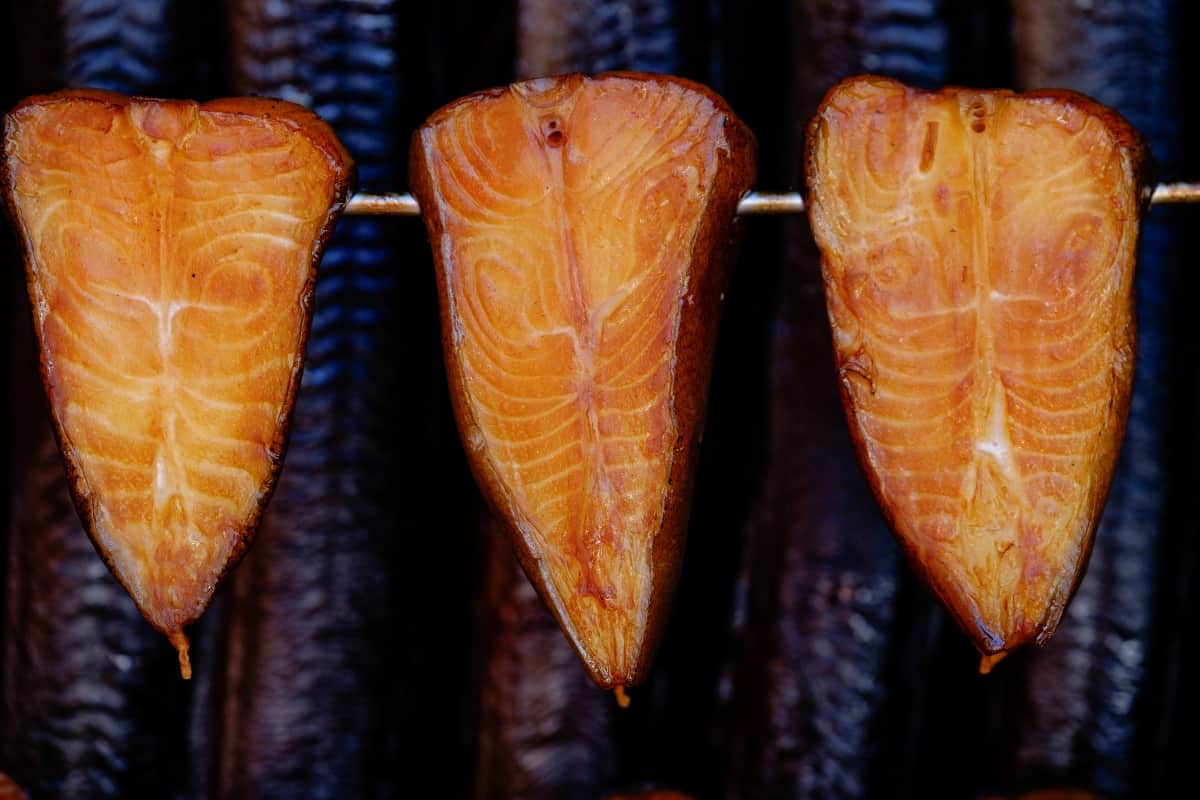
The best wood for smoking fish and seafood is alder, which stands alone as the very best. It is mild, well-balanced, not at all overpowering, and lends a great smoky overtone while allowing delicate fish flavors to shine through.
Other mild-flavored wood smokes that suit well are:
- Apple
- Ash
- Beech
- Birch
- Maple
- Orange
Though if you want a real kick of smoke on your fish, still without totally overpowering it, the following bolder smoke flavors go well:
- Cedar (particularly for salmon)
- Cherry (though it will discolor skin and flesh slightly red)
- Hickory (use sparingly, though, as it’s potent!)
- Oak
- Plum
Logs, Chunks, Chips, Pellets, and Sawdust, When and How to Use Each
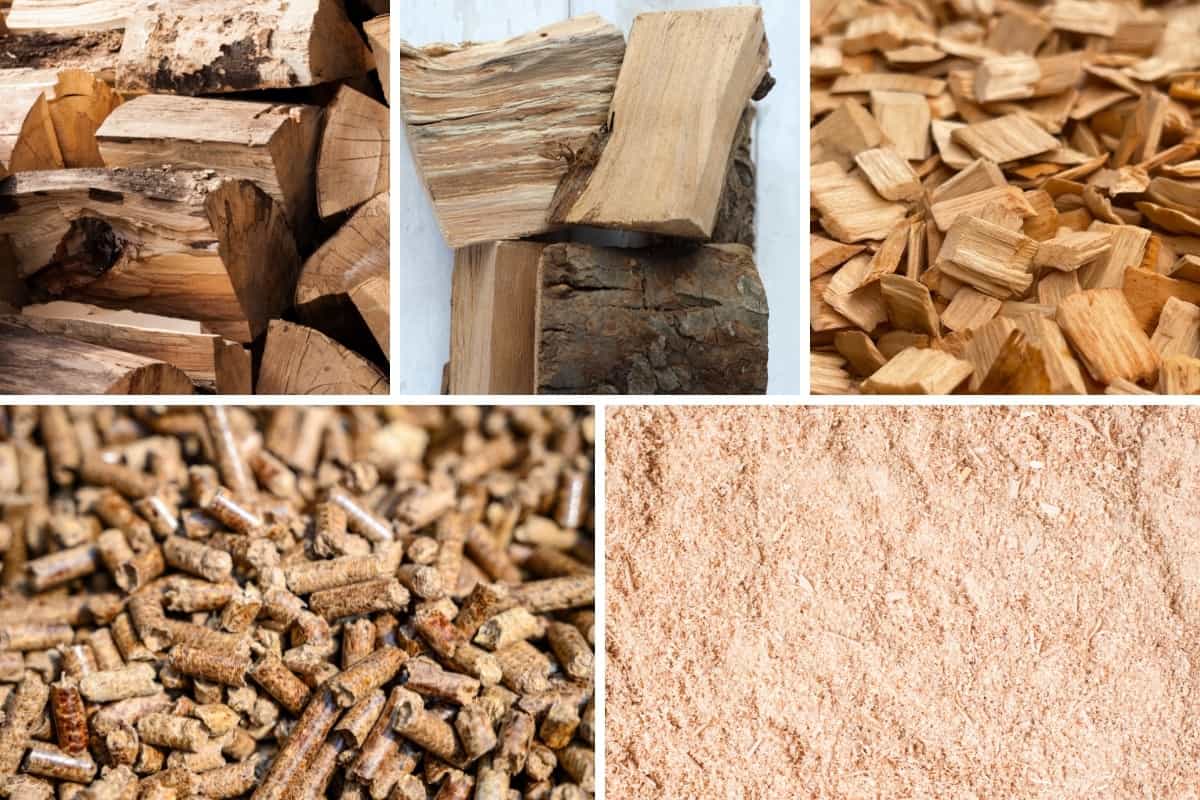
There are six basic forms of wood used for smoking, logs, chunks, chips, pellets, sawdust, and planks.
Your smoker type largely dictates your choice of wood. Most smokers accommodate various wood forms, but typically, the following is the preferred and typical way to do things.
When to Use Logs
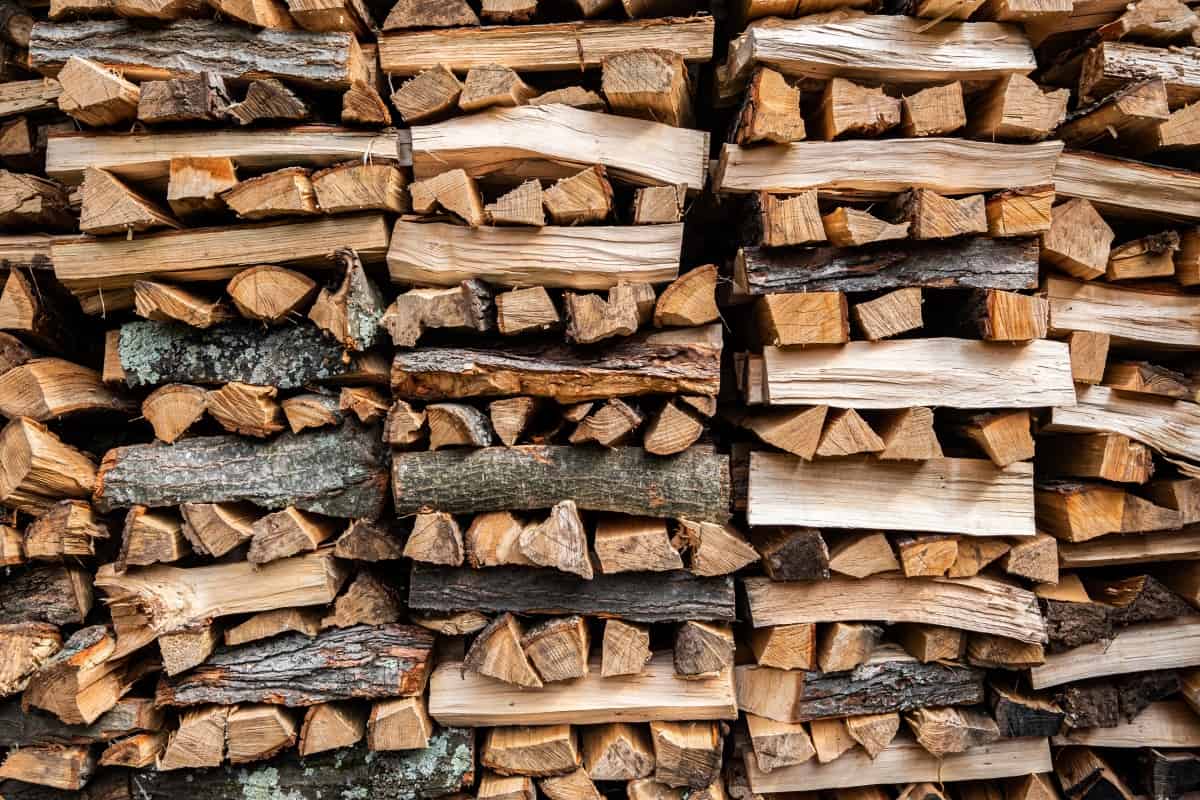
Logs are for pit grilling, monster offset smokers, pulley pits, fire pits, and commercial settings.
Wood splits typically measure 18 inches, with variations ranging from 12 to 24 inches to suit the size of the smoker’s firebox.
Logs serve as both the heat source for cooking and for imparting smoky flavor to food. They are usually burned down to embers before adding meat. The target cooking temperature is commonly 225 °F, sufficient for smoke generation. But for complete combustion and achieving the ‘burning bush’ stage and ‘blue smoke’, a cooking temperature of 275 °F is often recommended.
When to Use Chunks
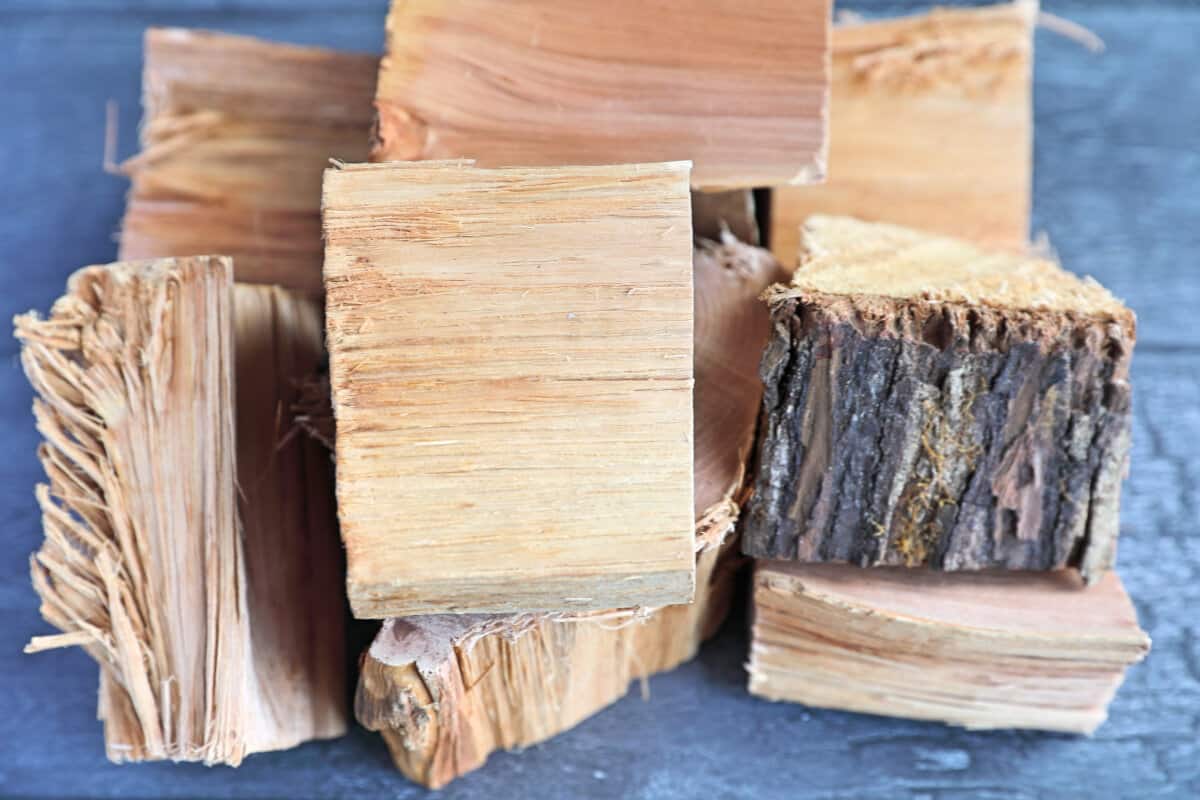
Wood chunks are suitable for charcoal smokers and grills, including kamado ceramic grills, water smokers (like Weber Smoky Mountain), ugly drum smokers (UDS), smaller offset smokers, and other charcoal-burning equipment.
These chunks, ranging from 1 to 4 inches, quickly generate smoke and burn comparatively longer compared to chips, reducing the need for frequent replacement during smoking sessions.
Chunks are exclusively used for smoke flavor, not as a primary heat source. Typically, they are placed on or embedded in the charcoal, igniting and smoking as the fire moves through the charcoal bed.
When to Use Wood Chips
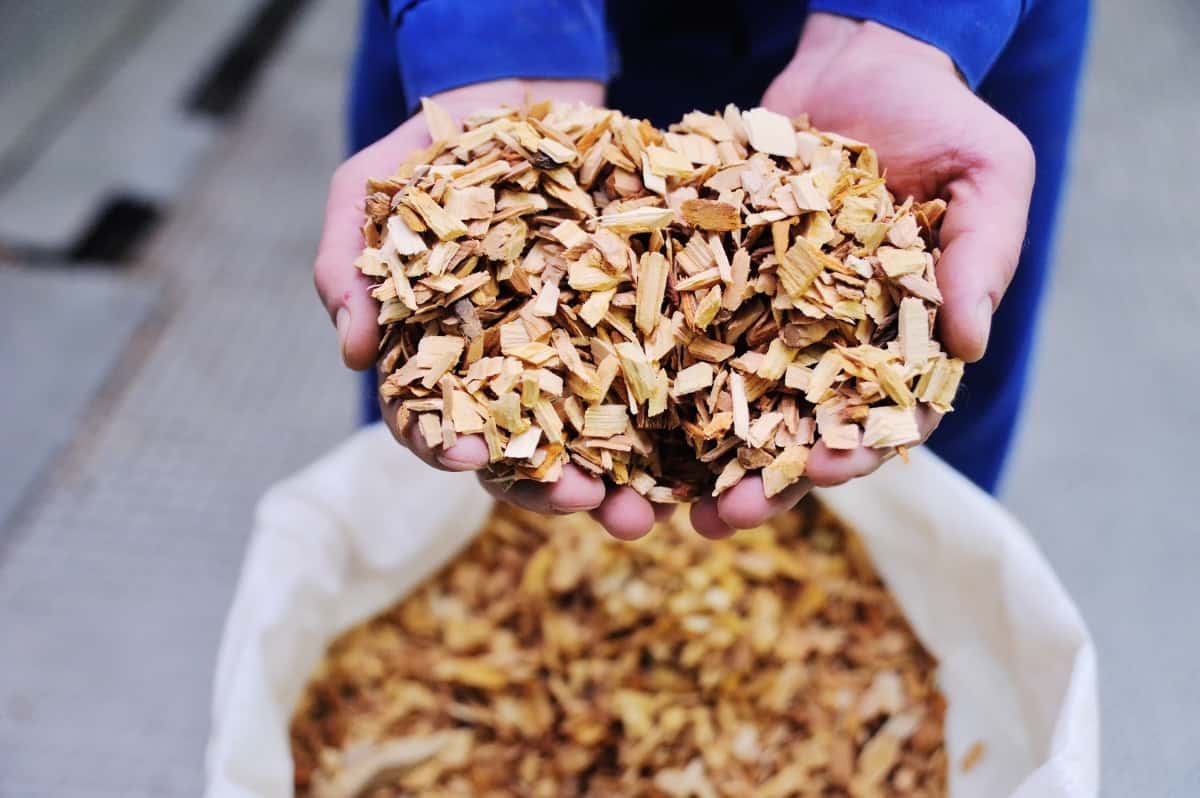
Wood chips are suitable for electric and gas smokers, and often for gas grills. They can also be used with charcoal, although chunks are generally preferred because chips burn too fast.
These chips are small pieces of real wood, varying from 1/4 inch to 3/4 inch thick and 1/2 inch to 1 inch long.
As a fast-burning option, wood chips are popular in grills and non-commercial smokers due to their convenient size and availability. However, they burn out quickly and require frequent replenishment. To prolong burn time and reduce oxygen access, wood chips can be placed in smoker boxes or enclosed in foil pouches.
When to Use Wood Pellets
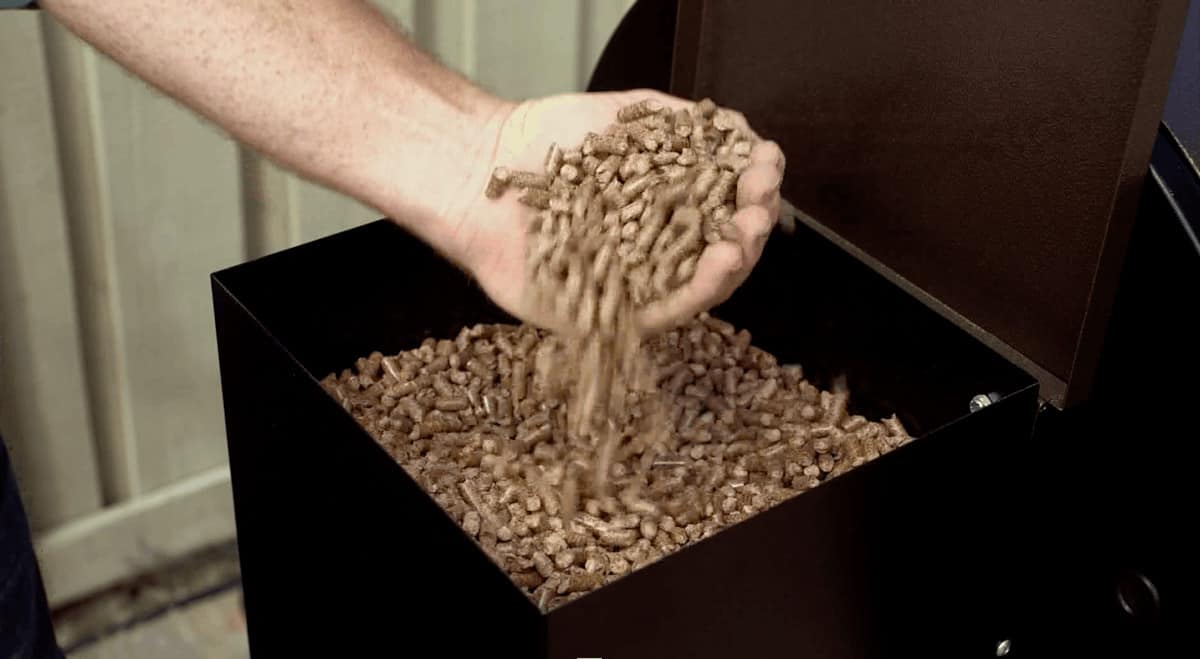
Smoking wood pellets are pretty much just sawdust compressed into half-inch pencil-shaped rods, or sometimes small rectangles called briquettes.
Pellet smokers can be fueled solely by compressed sawdust products, which serve as both the heat source and smoke generator. However, pellets can also be used in smoker boxes on gas or charcoal grills, providing a touch of smoke to the food without contributing to the heat.
When to Use Sawdust
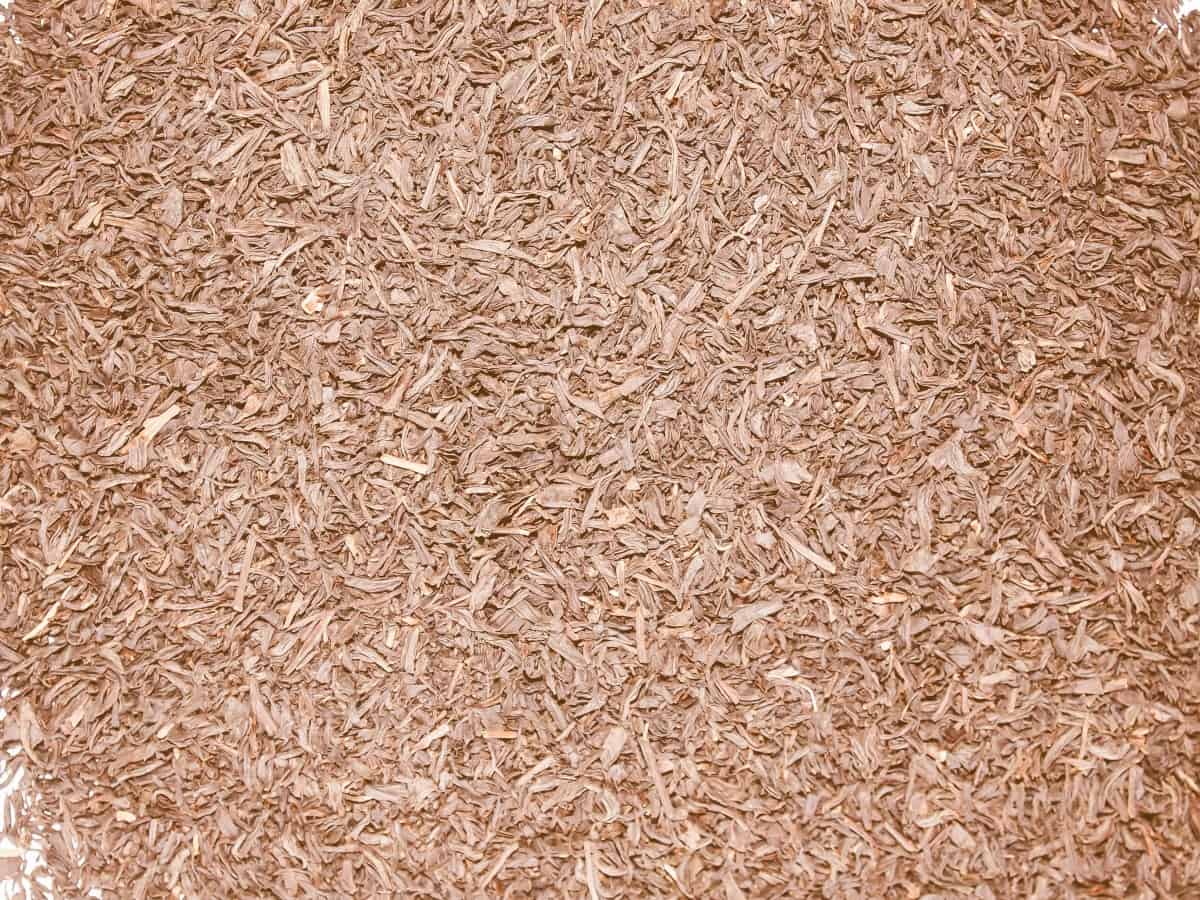
Sawdust is particularly effective in handheld electric smoke generators, commonly known as smoke guns, for quickly smoking foods like fish and cocktails. Additionally, it’s widely used in cold smoke generators.
Sawdust is finely ground wood dust or powder. It burns rapidly and provides smoke for only a brief period of time. It’s ideal for electric smokers without an open flame, where the electric heating element causes a slow smolder instead of outright burning.
When lit in a single spot and the flames are extinguished, sawdust can smolder slowly, producing a low volume of smoke for several hours, suitable for cold smoking items such as bacon, cheese, and fish.
When to Use Planks
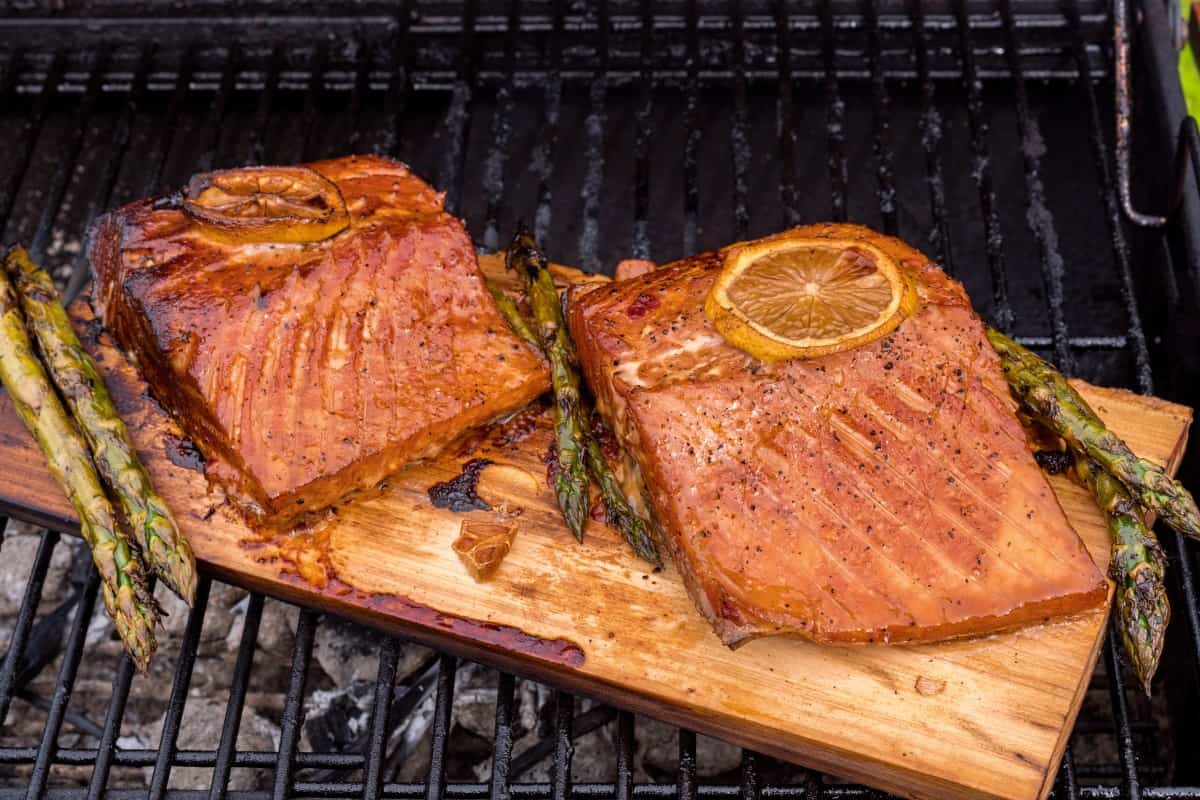
Use planks primarily for cooking fish. When fish is nailed to these planks and placed over a direct heat flame, the wood heats up, begins to burn and smoke, infusing the food with a smoky flavor.
Smoking wood planks are typically rectangular pieces of wood measuring 13 x 7 inches, and are used as cooking surfaces in smokers and grills, including gas and charcoal grills and live fire smoke pits.
While cedar is a common choice, experimenting with different wood types for various meats is recommended: olive planks for lamb, black cherry for beef, and sugar maple for chicken. This method offers a wide scope for creativity.
How Much Wood to Use and When to Add it — It Depends on Your Type of Smoker!
Determining how much wood to use, when to add it, and the right amount of smoke for your food depends on factors like your smoker’s style and size, its airflow, how well-sealed it is, the type of wood used, local weather conditions, and your personal taste preferences. To find your ideal balance:
- Maintain a smoking journal. It may sound like ‘work’, but it will pay in the long run! Record details like the type of meat, smoking temperature, type of wood, amount of wood used, and the duration of smoking. Note if the food was too smoky or not smoky enough, then adjust the wood amount and smoking time accordingly. Over time, this will help you discover your preferences.
- Start with a small amount of smoking wood and aim to under-smoke your food. Over-smoked food can be bitter and unpleasant, so start small and mellow. Gradually increase the amount of wood in subsequent cooking sessions until you achieve the desired flavor.
Finding the right smoking method involves experimenting and noting the outcomes on your specific BBQ, with the available wood in your location and climate, to match your taste.
I was advised years ago by a more experienced BBQ friend to keep a live journal and take notes of all my cooks. I believe it was the best advice I’ve ever been given, that has had the greatest impact on my BBQ overall. How can you learn from your mistakes and successes, if you can’t even remember them? So take notes, and refer to them often.
However, here’s what I do for different types of equipment, which will help you get started on the right foot:
For Charcoal Smokers and Grills
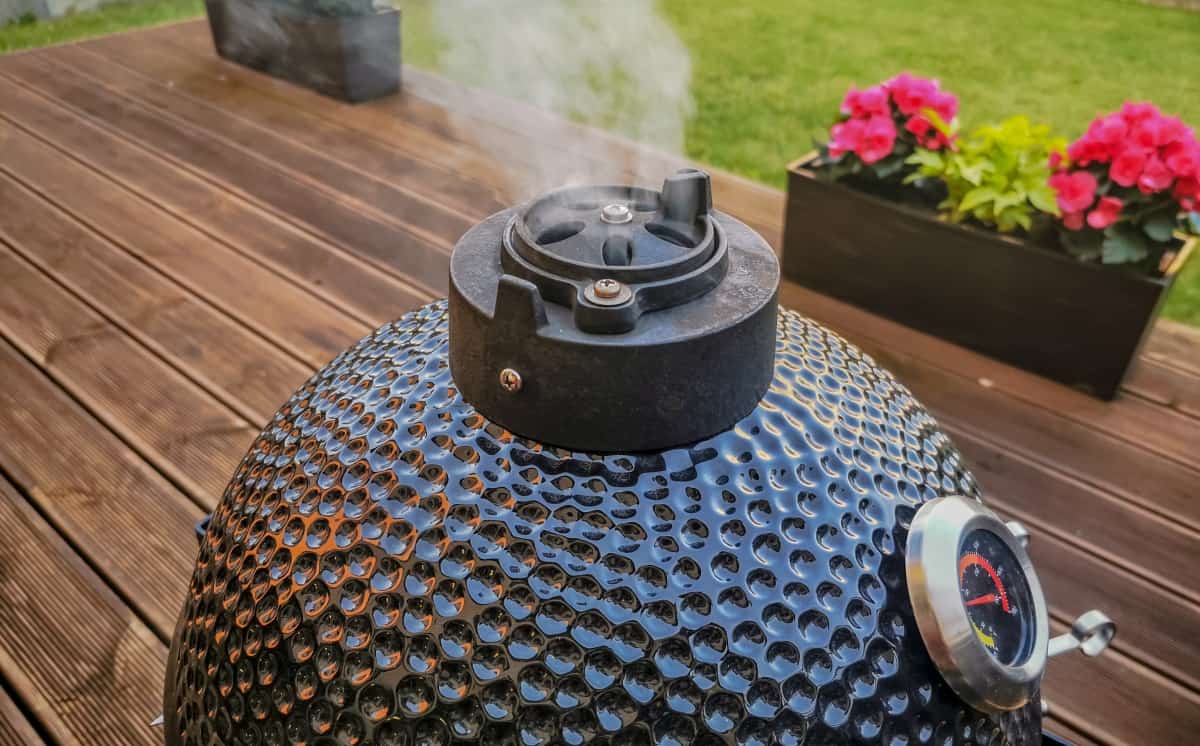
For charcoal grills smokers, use smoking wood chunks.
For delicate flavored items that are easy to overpower, such as chicken, turkey, or fish, start by using just a single fist-sized chunk of smoking wood placed onto a small, concentrated hot fire after letting your smoker come up to temperature.
For smaller cuts of beef and pork, start by adding two fist-sized chunks of smoking wood, one right on top of the fire, and some just beside it to ignite and burn some time after the first chunk burns out.
For large cuts of pork and beef such as ribs, pork butt, or brisket, start with three or four fist-sized chunks spread out to light at different times, or start with two chunks and add the third and fourth when your cooker stops smoking.
Take notes on the results, and dial things up or down from there in the future.
For Charcoal Grills
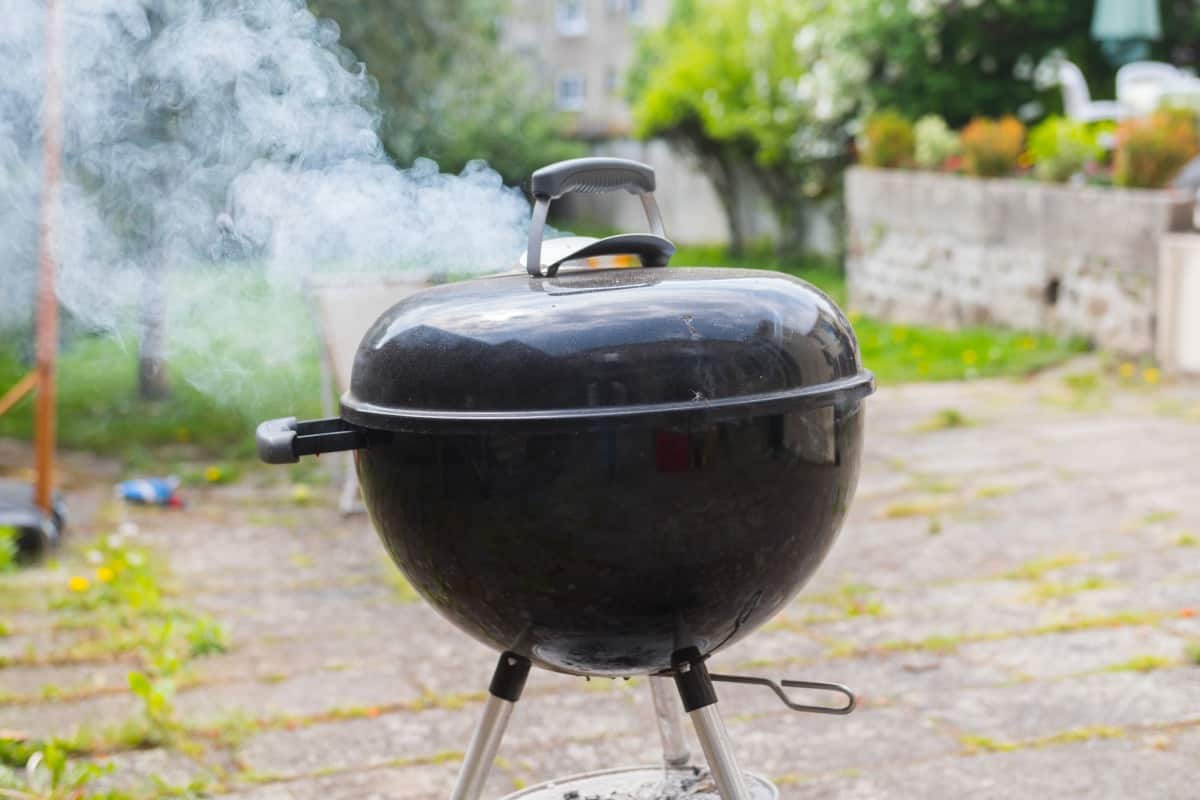
Set up your grill to smoke using the charcoal snake method, and follow the same guidelines for the amount of wood to use as above for charcoal smokers.
Make sure to place all smoking wood right at the start of the snake, so smoke is generated for the earliest parts of the overall cook.
For Pellet Smokers
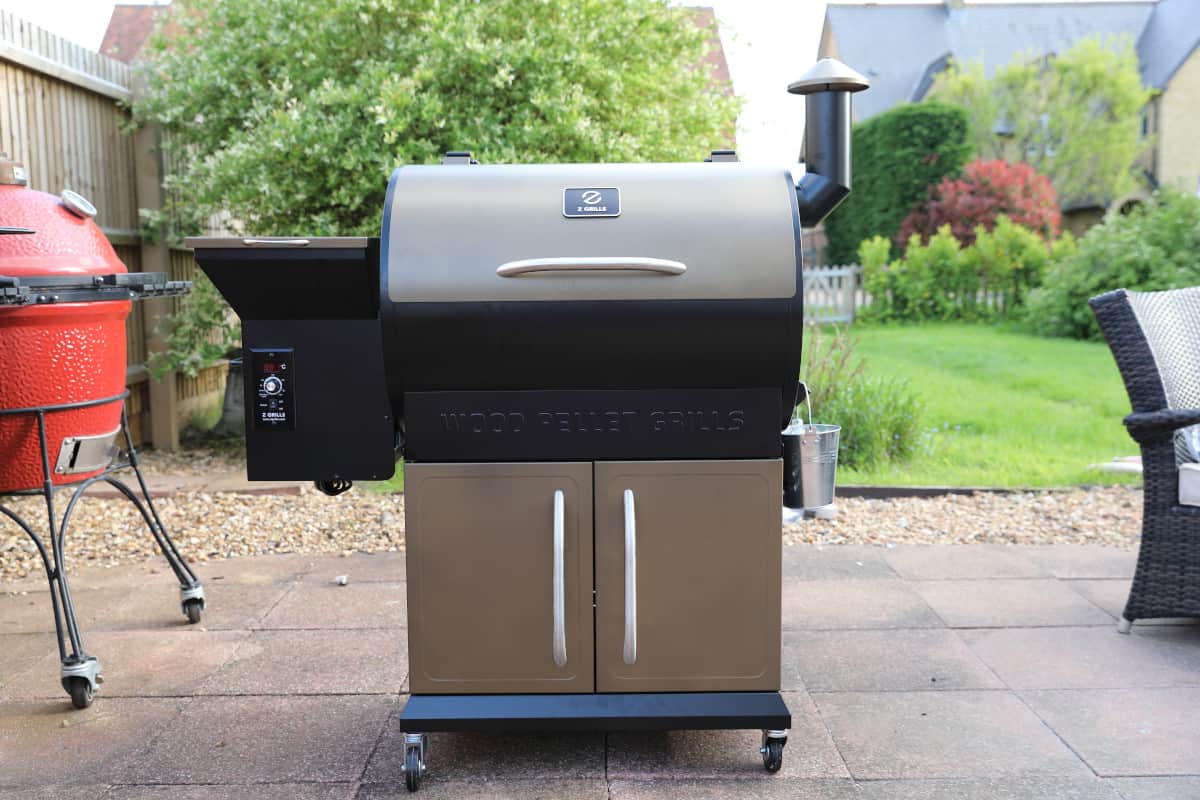
There’s no advice needed for pellet smokers because the wood is both the source of heat and the source of smoke.
Simply fill up your hopper, set your cooking temperature, and cook away until your food is ready.
For Electric and Gas Smokers
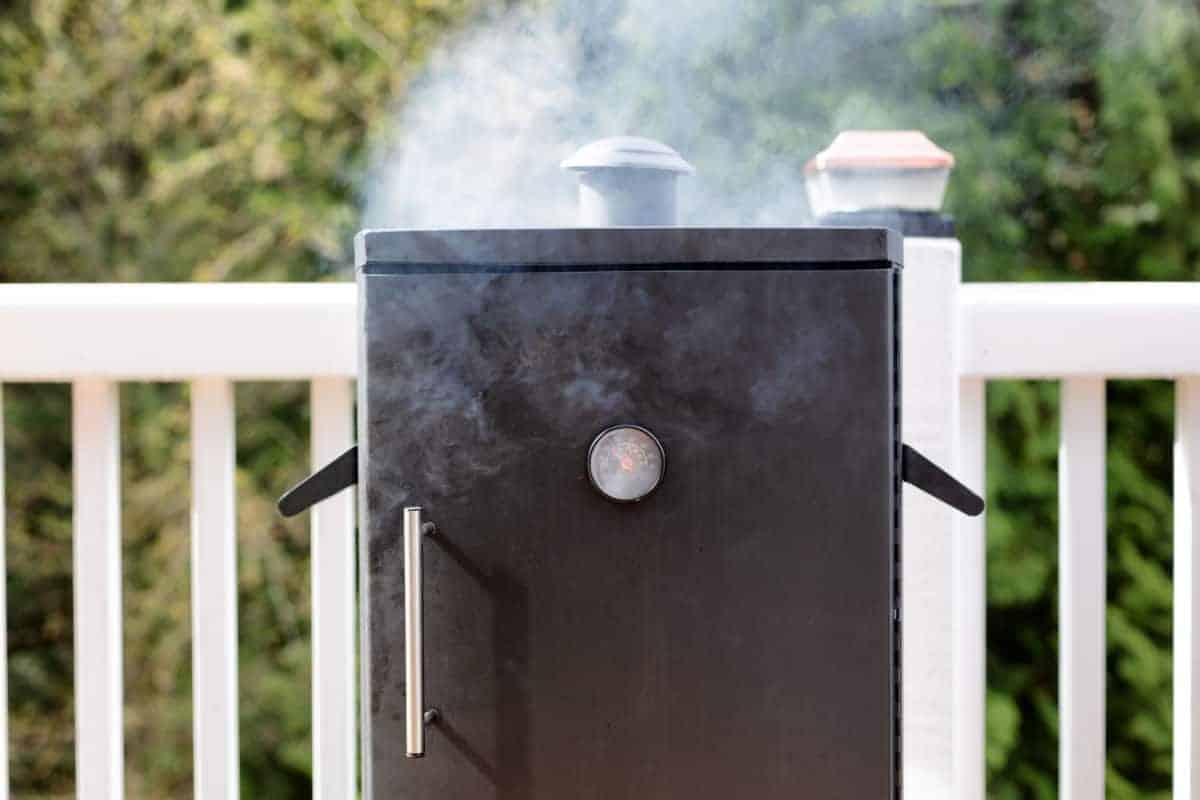
Use smoking wood chips for electric and gas smokers. Always fill the supplied chip tray right up, then choose your overall smoking time from the following advice:
- For delicately flavored items such as chicken, turkey, and fish, start by smoking for 30 minutes.
- For smaller cuts of beef and pork, start by smoking for 90 minutes.
- For large cuts of pork and beef (brisket, butts, and ribs), start by smoking for 3 hours.
In all cases, take notes on the results, and increase or decrease smoking time depending on if you found things too smoky or not smoky enough.
For Gas Grills
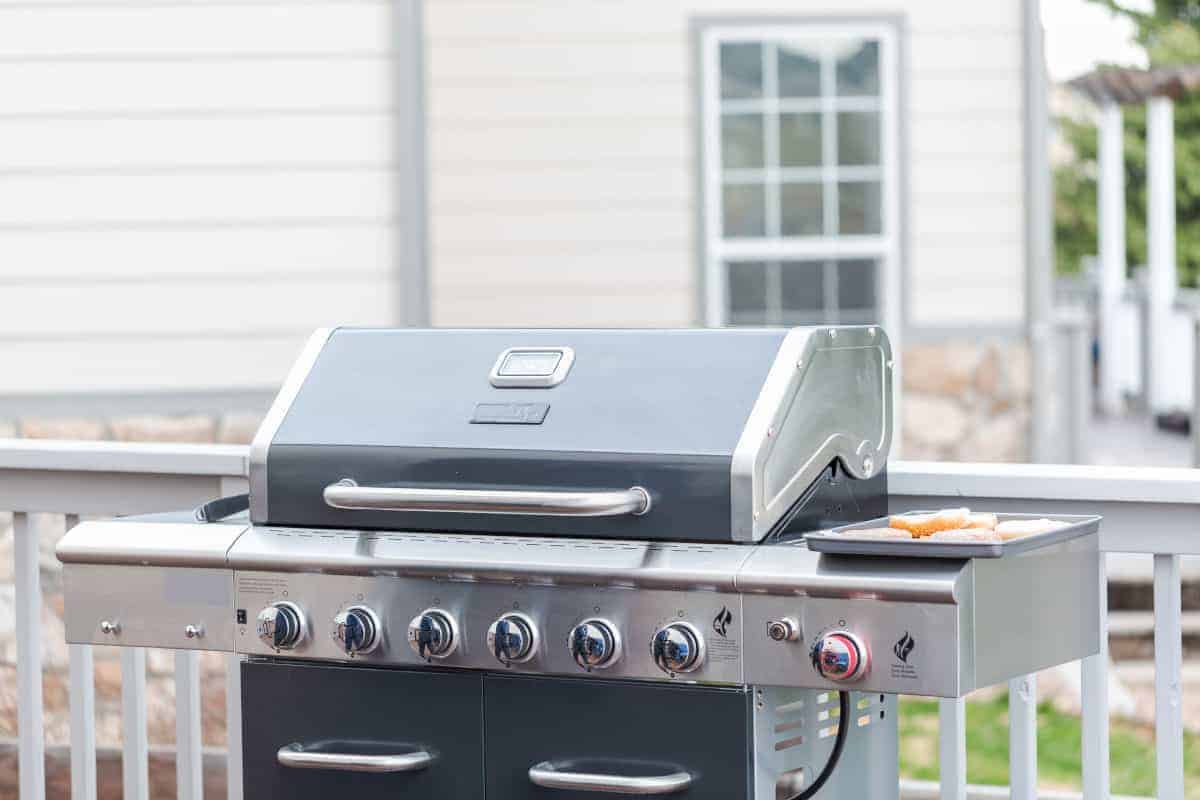
For gas grills you preferably use wood chips in a foil packet or smoker box, though you can place wood chunks directly on the grate over a burner if you wish.
Place wood chips in smoker boxes or foil packets in your grill and wait for them to start smoking before adding your food, as it takes time for them to combust and create smoke. Gas grills, due to their design, have significant ventilation and are quite leaky, causing most of the smoke to escape without reaching the meat. Therefore, more smoking is required in gas grills compared to more efficient smokers. So follow this advice:
- For delicately flavored items such as chicken, turkey and fish, smoke for the entire cook.
- For smaller cuts of beef and pork, also start by smoking for the entire cook.
- For large cuts of pork and beef, start by smoking for 4 hours.
As always, take notes, and increase or decrease smoking time depending on how you find the results.
How Long Should You Create Smoke for?
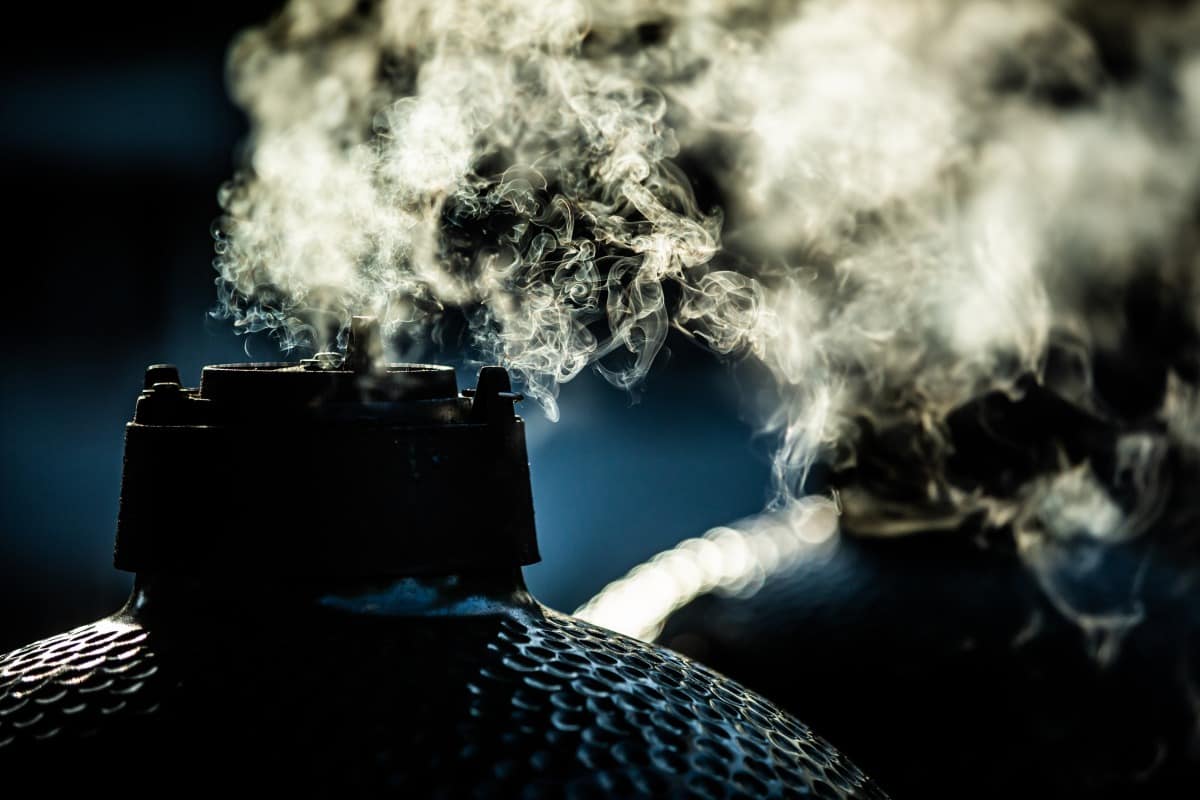
For small, quickly-cooking items like steaks, chops, fish, and vegetables, smoke for the entire cooking time. Their short cook time makes it almost impossible to over-smoke them. However, for larger cuts like ribs, brisket, pork butts, and shoulders, which can take 5 to 16 hours to cook, whether to smoke for the entire duration or just part of it depends on your personal preference and desired smoky flavor intensity.
A good rule of thumb is to smoke for about half of the total cooking time or for around 4 hours, whichever is shorter. After tasting the finished product, adjust the smoking time in future cooks based on whether the food is too smoky or not smoky enough.
There’s a common myth that meat stops absorbing smoke at an internal temperature between 135 and 145 °F, but this is false. Meat continues to absorb smoke throughout the cooking process, although the rate significantly decreases as the cook progresses.
The reduction of smoke absorption is due to the formation of BBQ bark, where the meat’s surface becomes hot and dry, making it more challenging for smoke to adhere compared to a cold and wet surface. However, by basting or spritzing the meat during cooking, the surface temporarily cools and wets, allowing more smoke to adhere.
As always, it’s essential to keep notes to find your ideal balance. Be cautious, as food can become excessively smoky without care. Smoking for an extended period, like 16 hours, might be too intense for most tastes, akin to eating an ashtray. It’s better to start with less smoke and gradually increase it over subsequent cooks.
A Few Words on The Smoke Ring
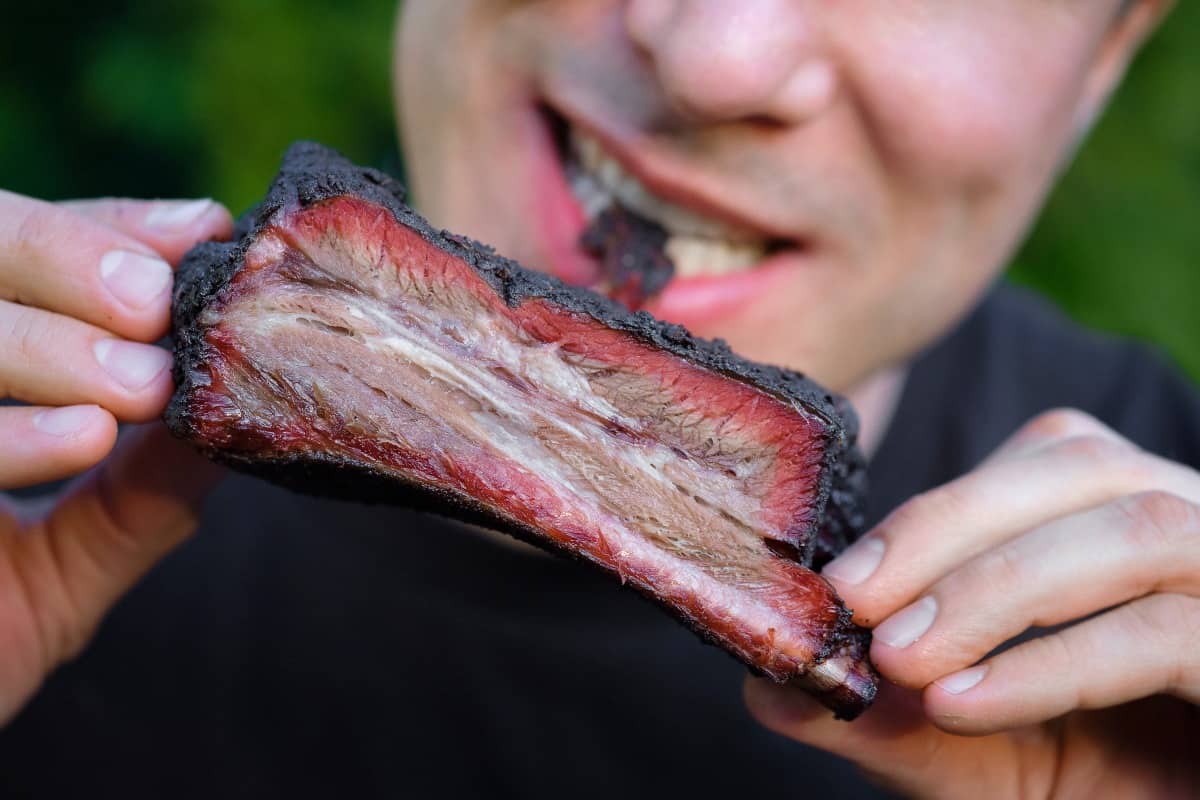
We have an article discussing the smoke ring in depth, but I thought I’d summarize it here as it’s such a hot topic and related to this discussion.
When wood burns, as mentioned in the third stage of combustion, ammonia and hydrogen cyanide combine with oxygen to form nitric oxide. Inside meat, a protein called myoglobin, responsible for holding oxygen in muscle cells, contains hemes, pigments that give muscles their red color. The meat’s redness depends on the concentration of hemes; the more hemes, the redder the meat.
Exposure to air causes meat to oxidize and lose its red color, turning brown, a process that also occurs during cooking. However, the presence of nitric oxide, generated from burning wood when smoking meat, penetrates up to a centimeter into the meat. This reacts with myoglobin and hemes, stabilizing them and forming a new pink pigment that remains despite oxidation and cooking.
As a result, a pink band known as ‘the smoke ring’ forms on the meat’s surface, ranging from 0 to 10 mm thick at the surface, while the rest of the meat turns brown as it cooks.
Fun fact: Although many admire a smoke ring and view it as a sign of expert smoking technique, it actually has no impact on flavor. The smoke ring merely indicates that nitric oxide was present in the smoke during cooking, which isn’t always achievable depending on the fuel and type of cooker used.
Fun fact 2: You can artificially create a smoke ring by adding curing salts to the meat rub. Curing salts contain nitrates, responsible for the pink and red hue in cured meats like bacon. Using these salts in your BBQ rub will mimic the appearance of a smoke ring, as the nitrates form nitric oxide during cooking.
Sourcing Your Smoking Wood
If you don’t have access to a variety of trees for harvesting smoking woods, here are some alternatives:
- Local suppliers: It’s always nice to shop local. If you have a local BBQ shop, visit them to see their selection of smoking woods. They might offer competitive prices, particularly if there are no delivery fees.
- Online: Searching for ‘smoking wood supplier’ online will reveal several stores, including Amazon, offering a wide range of smoking woods. Though there may be minimum order requirements and shipping costs, the convenience cannot be beat.
- Foraging: If you have access to local, non-privately owned woods and forests, you can forage for wood. Look for fallen branches rather than cutting down trees. However, ensure you can identify the trees, as some woods are unsuitable and toxic for smoking. And remember to season the wood for about a year before use, as fresh, green wood is not suitable for smoking.
Should You Use Hardwood or Softwood?
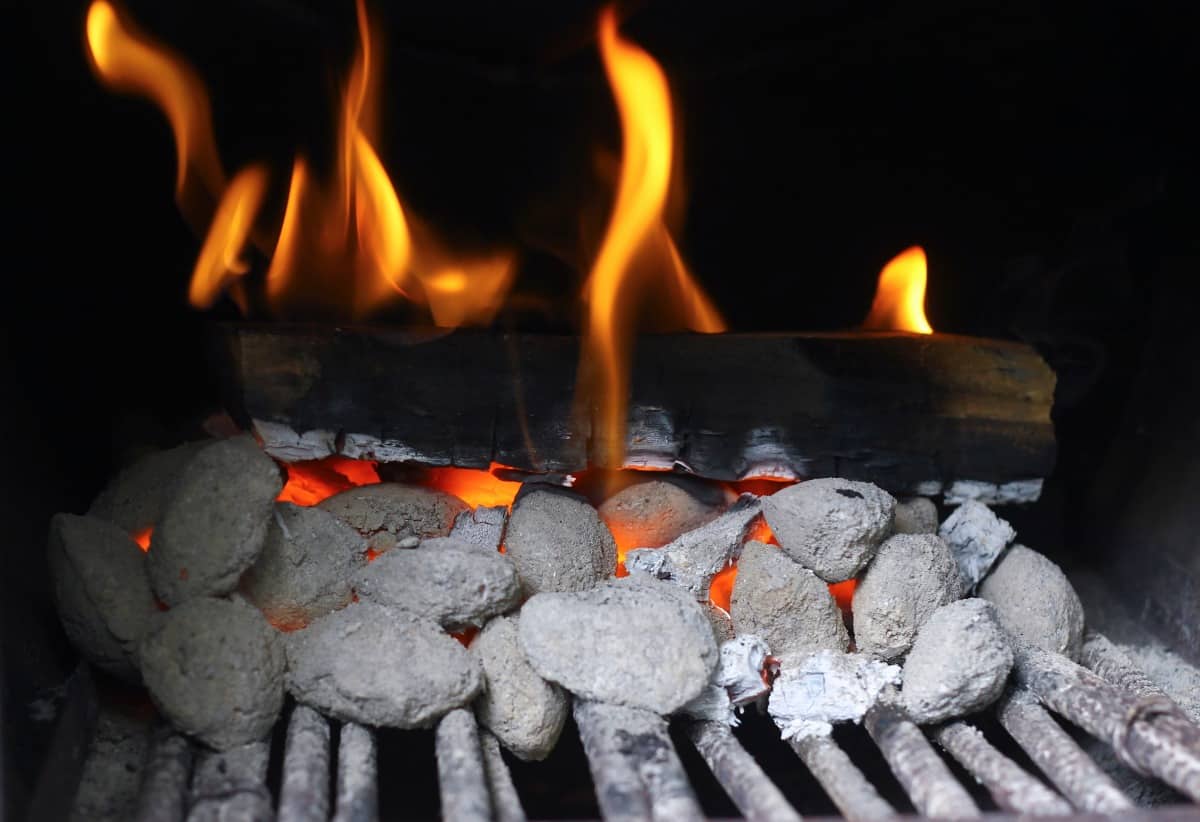
You should use hardwoods over softwoods because they burn slower and longer with smaller flames, producing less heat, soot, creosote, and fewer harmful compounds.
So how are hardwoods and softwoods defined? The simplest explanation I could find and that I’ll paraphrase and add to came from Horizonwood.com (since removed from their website, sadly.):
“To classify a wood as hard or soft depends on the seeds that the tree produces. A wood will be classified as a hardwood if the seeds that the tree produces have a coating. These coatings can either take the shape of a fruit or a shell. A wood will be classified as a softwood if the seeds don’t have any type of coating and are instead dropped to the ground and left to the elements.”
They also note that hardwood is commonly known as angiosperm, and is the wood that originates from blooming plants. The phrase “angiosperm” comes from the Greek word angiospermous, which means “vessel seed.” Oak, ash, maple, and beech trees are examples of these sorts of trees.
The wood that comes from gymnosperm trees, which have needles and form cones, is known as softwood. The Greek word gymnosperm means “naked seed.” Most of these trees are evergreen or conifers, such as cedar, Leylandii, pine, and spruce trees.
Avoid softwoods like pine, fir, cedar, and spruce, which are coniferous or evergreen trees identifiable by their needle or scale-like leaves. Due to their high content of saponins and terpenes, chemicals used in soap and foam-free fire extinguishers, softwoods impart an unpleasant taste to food and can sometimes cause sickness.
Opt for hardwoods, which are deciduous trees that shed their leaves in autumn and grow new ones in spring. With their low sap levels, hardwoods burn cleanly, producing a variety of pleasant aromas that enhance the flavor of smoked foods. Commonly used hardwoods for smoking include hickory, mesquite, oak, and various fruit and nut trees.
How to Prepare Wood for Smoking
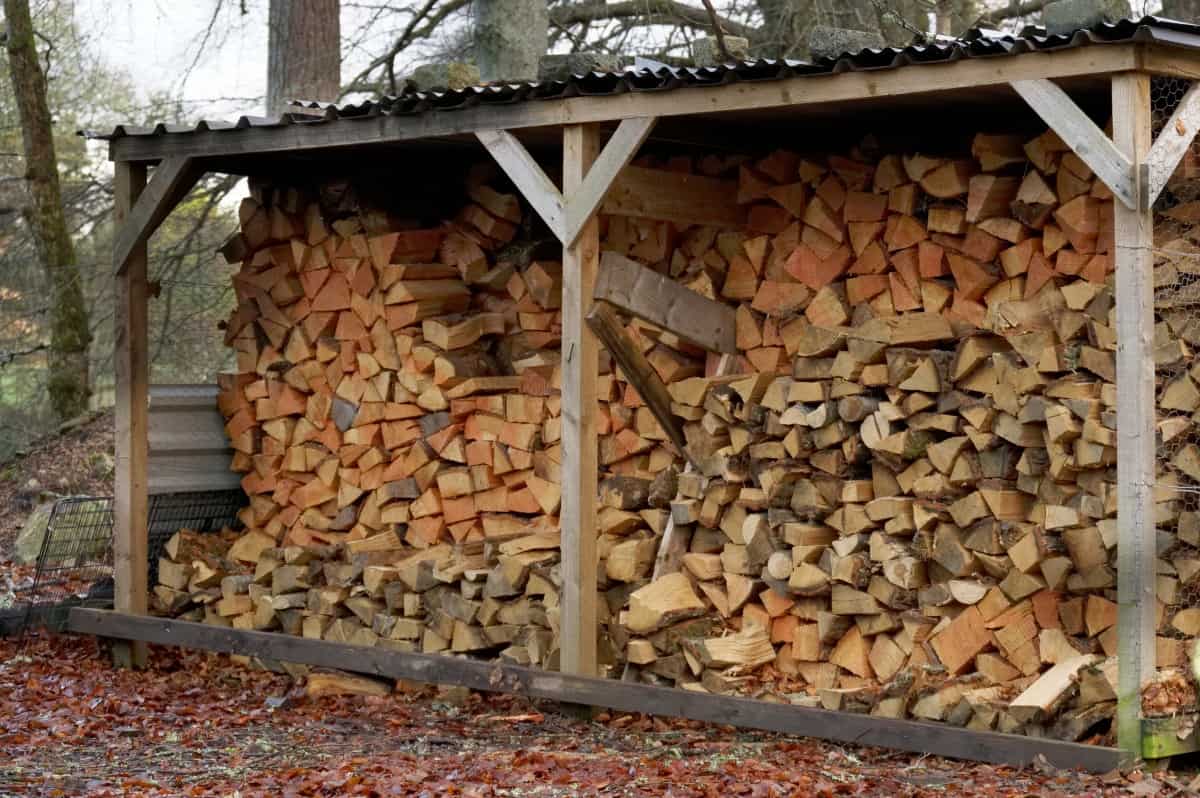
To prepare your wood for smoking you must dry it! Avoid using immature, freshly cut or green wood that contains nearly 50% by weight of water, which makes it unsuitable for smoking. It needs 45% more energy to burn and produces excessive steam, which carries substances leading to an unpleasant flavor in the food, says Meathead of AmazingRibs.com
Seasoning, or drying, the wood before use is crucial. Well-seasoned wood typically has only 20 to 25 percent of its original water content.
There are two basic methods for wood drying:
- Air-drying involves stacking the wood to allow air circulation. This method retains some moisture, causing the smoke particles to clump together and adhere more readily to the meat. It also affects the nitrate/nitrogen ratio, resulting in thicker smoke rings. Air-drying usually requires at least a year.
- Kiln-drying places wood in a controlled oven to regulate airflow, temperature, and humidity. It ensures more uniform drying but can cause honeycombing or splitting, which is not an issue for smoking purposes.
Kiln-dried wood imparts a milder smoke flavor to food compared to air-dried wood. This is because the high temperatures used in kiln drying can reduce the levels of volatile compounds in the wood that contribute to the smoke flavor
On the flip side, air-dried wood often retains more of its natural compounds, including those that contribute to a stronger smoke flavor. However, the variable moisture content of air-dried wood can affect the intensity and quality of the smoke produced. And if not properly seasoned, air-dried wood can have too high moisture content, leading to incomplete combustion and more undesirable creosote.
Should You Soak Your Smoking Wood?
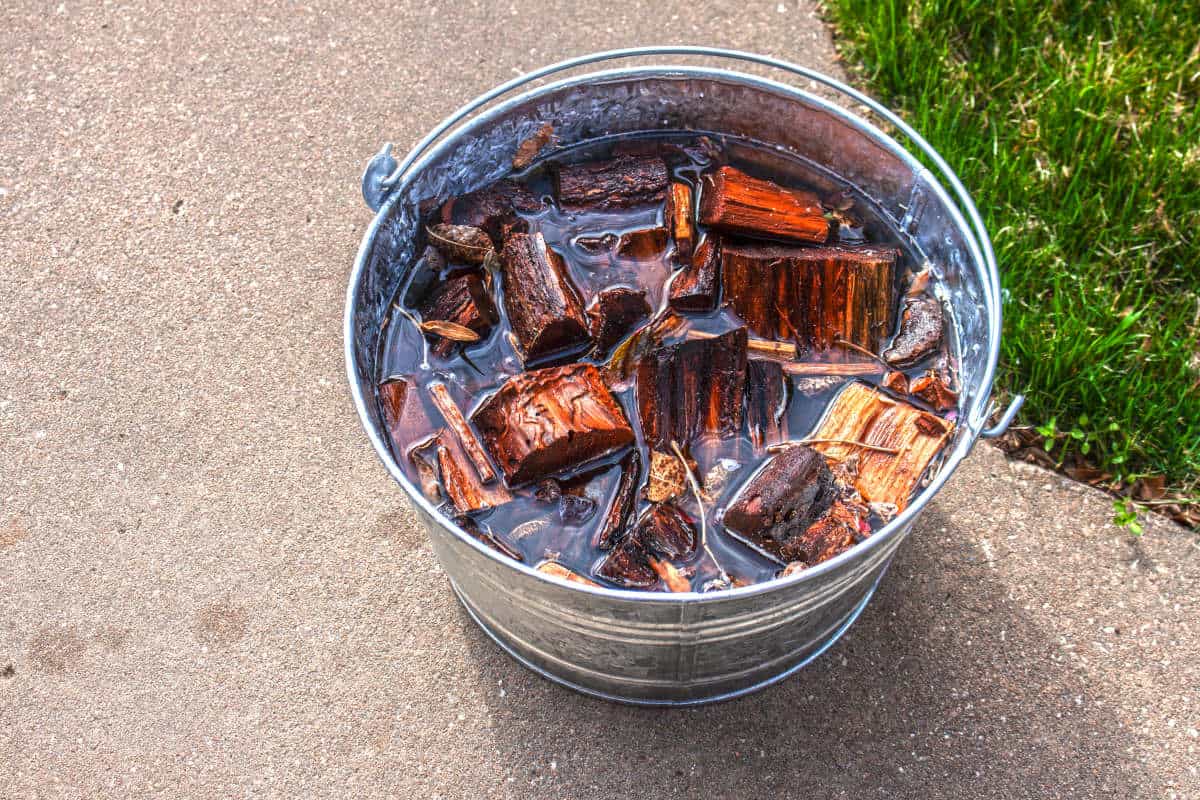
No you shouldn’t soak your smoking wood. Soaking only delays smoke production without any additional benefits. When soaked, wood initially produces steam, not flavorful smoke, as it must dry out before burning.
However, there is a caveat to this. If using a gas or charcoal grill and leaving it unattended, soaking some wood can prolong the smoking time. For instance, placing both dry and soaked wood in separate foil packets on the grill leads to a longer, continuous smoke. The dry wood smokes first, followed by the soaked wood after it dries and ignites.
Should You Remove the Bark?
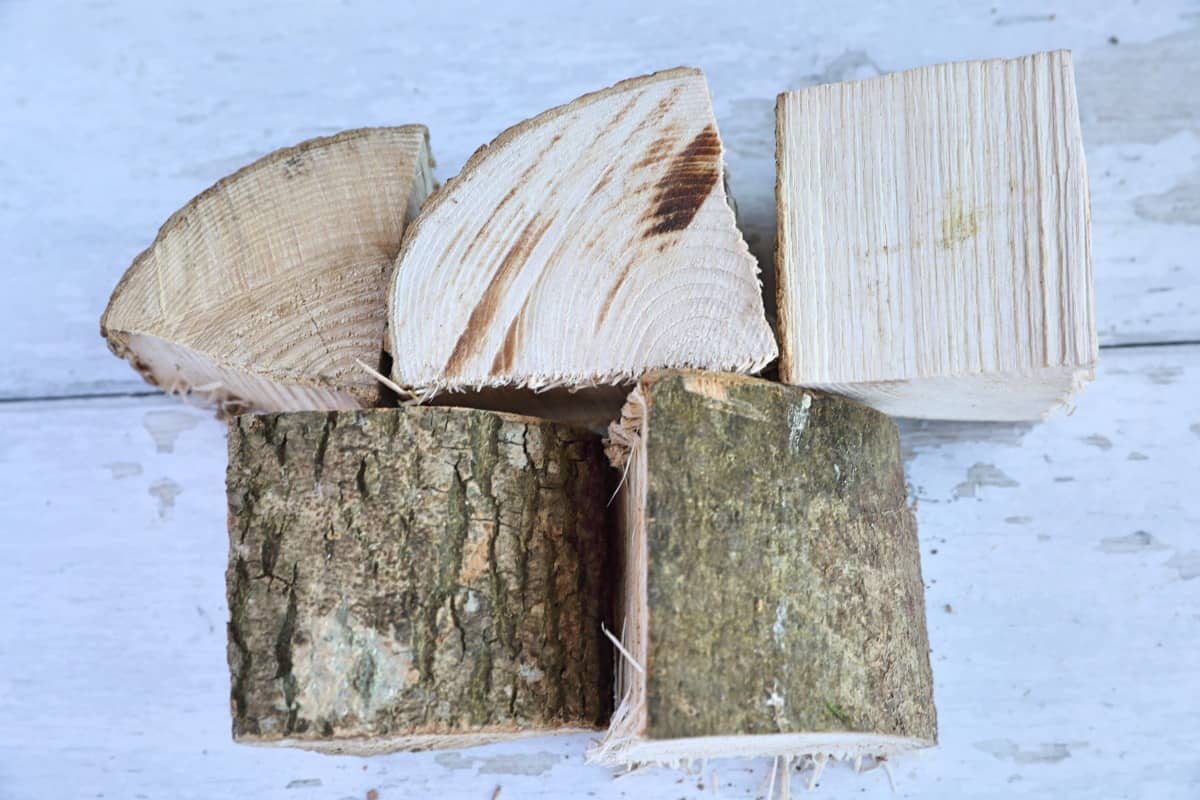
Removing bark from smoking wood is largely based on personal preference. While bark’s chemical composition differs from heartwood, impacting flavor due to its lower density and different burn characteristics, the small amount of bark relative to heartwood usually results in a minimal flavor difference. And this is not a difference that I was able to detect in my experiments.
Personally, I remove easily detachable bark but leave it on if it’s difficult to peel.
However, always remove birch bark, as its high oil content creates thick smoke which negatively affects the taste.
Wood Chunk and Tree Identification Guide — Photos and Descriptions
I did have an entire guide to identifying smoking wood here, but it’s long. VERY long, so I moved it into its own article which you can find here: Smoking wood identification guide.
Further Resources for Identifying Trees
If the above descriptions and pictures aren’t enough, get a good reference like these three taken off the shelf of the local library:
- National Wildlife Federation® Field Guide to Trees of North America
- Trees (Smithsonian Nature Guide) by Tony Russell
- The Sibley Guide to Trees by David Allen Sibley
The e-book version of the Trees of Eastern North America (Princeton Field Guides) also came in handy.
Alternatively, many great websites have detailed descriptions of trees, many handy photos, and good search features. Find them by Google searching for ‘ identification. Here are a couple of good sites to get you started, though:
Conclusion
Throughout this article, we’ve covered the intricacies of wood selection, preparation, and application in the smoking process.
Remember, using clean blue smoke and the right type and amount of hardwood for your particular smoker type is the key to success and will make all the difference in your final dish.
From the initial stages of wood burning to the creation of the much-coveted smoke ring, I hope this ‘ultimate guide to smoking wood’ has delivered on its promise to elevate your smoking game. If you have questions about getting that perfect smoke, feel free to drop a comment below.


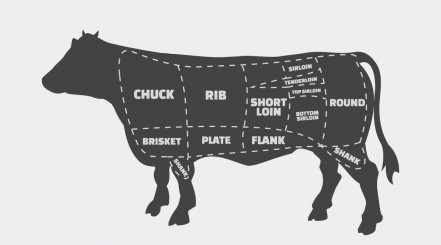

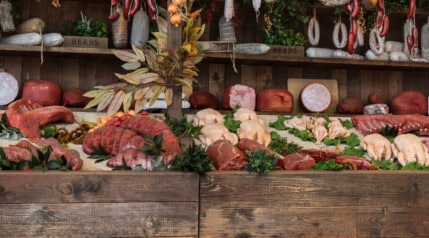
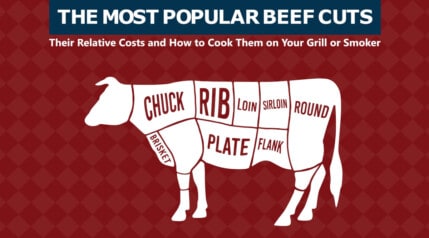
Great reading. Very informative. Thank you so much 😀
I officially feel like a smokeologist
lol. Thanks, Sean!
It’s so informative I have learned a few new things.
Great article. Best review of woods for smoking I’ve seen. As a typical highly opinionated smoke cooker myself, I couldn’t find anything to disagree with and learned some things, to boot! Thank you.
Thanks Steve, it’s always nice to hear things like this.
What an excellent article! Well written and thoroughly researched. I became a certified BBQ judge in 2009, but have been relatively inactive much of the last decade. My biggest pet peeve is hearing/reading people claiming that meat “quits taking smoke…”. You explained that well, but left out the other factor people say that. As I understand, the smoke ring quits developing in the 145 degree range, and cooks claim that’s when meat quits taking…yeah, OK.
Last comment–a much overlooked wood is pistachio. Also very difficult to find, probably more so in GB. But it does magic things to turkey. I hope to score some again someday!!
Thanks, David. I’m glad you found it useful.
“As I understand, the smoke ring quits developing in the 145-degree range, and cooks claim that’s when meat quits taking…” — Oh, I hadn’t heard this before. I do like a smoke ring, it’s visually pleasing, but as we all know it has no bearing on the taste or quality of the food, or the skill of the chef. I’ll read around and see if I can find examples of people saying this, then add it to the article. Thanks for the heads up.
“Last comment–a much-overlooked wood is pistachio” — This makes sense as pretty much all fruit and nut woods make great smoking woods, but I’ve never encountered it before. I’ll keep an eye out and snap some up if I get the chance, though.
All the best,
Mark.
Recently started smoking with a pellet smoker. We are pretty health conscious and started with veggies. We do smoke meat as long as it is locally sourced and we know where it came from (live in rural farm Midwest). Do you have any woods you would recommend for smoking veggies? We currently have been using Hickory.
Hi, John.
The best woods for smoking vegetables are generally mild to medium in flavor, allowing the natural flavor of the vegetables to shine through without overpowering them. If the smoke taste on veg is too strong is can be off-putting, completely masking their flavor instead of complementing it.
Therefore use milder flavored woods such as: Alder, applewood, cherrywood, or maple. For a slightly stronger smoky hit go for pecan, and potentially hickory but only in moderation as it can be too strong.
I hope that helps.